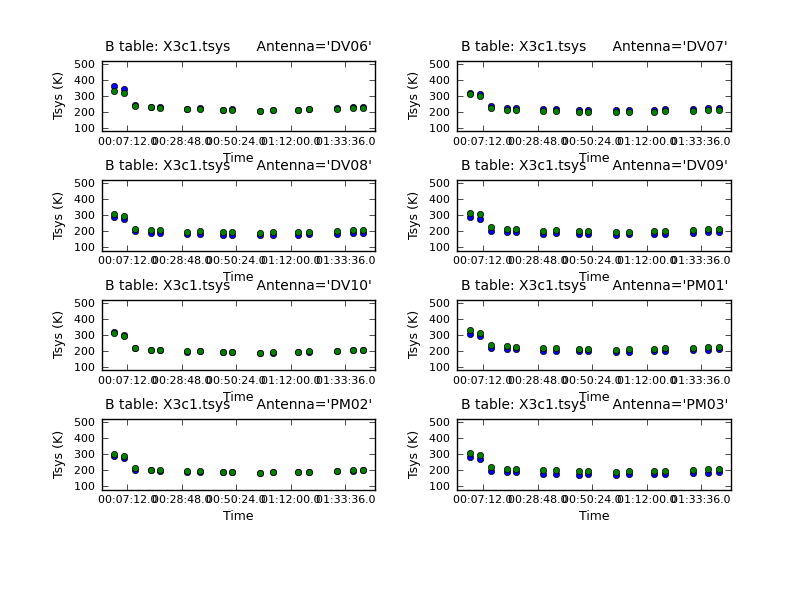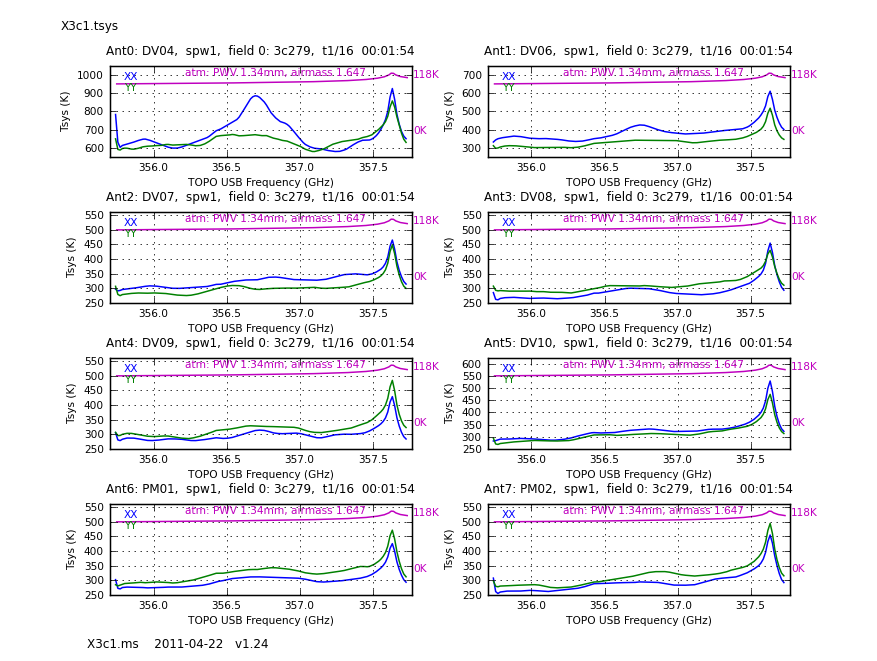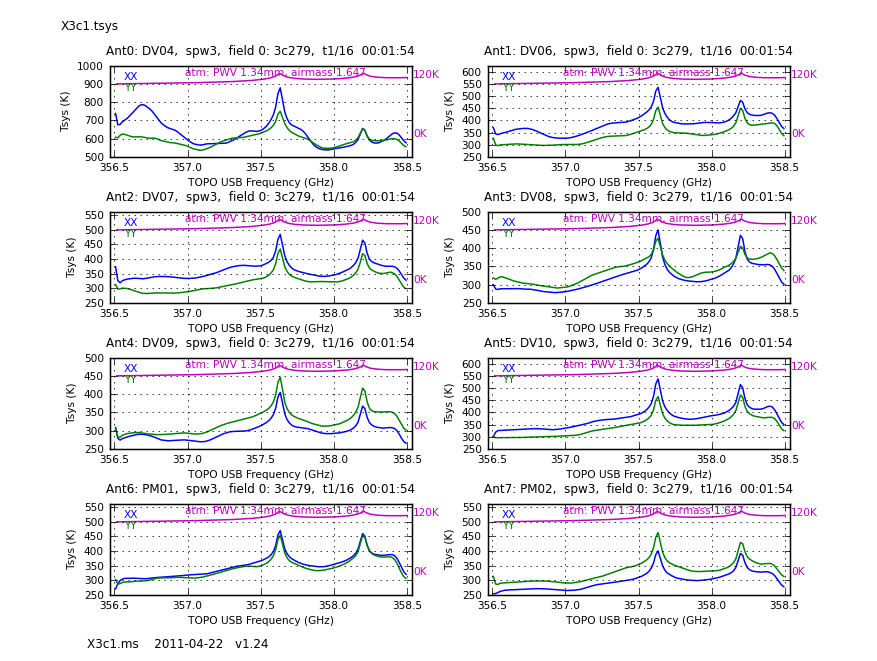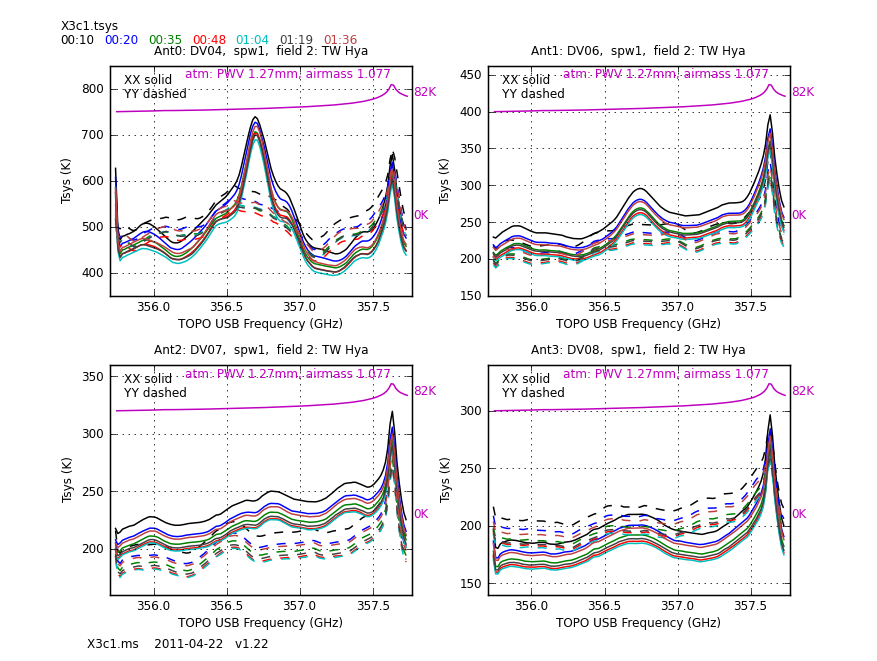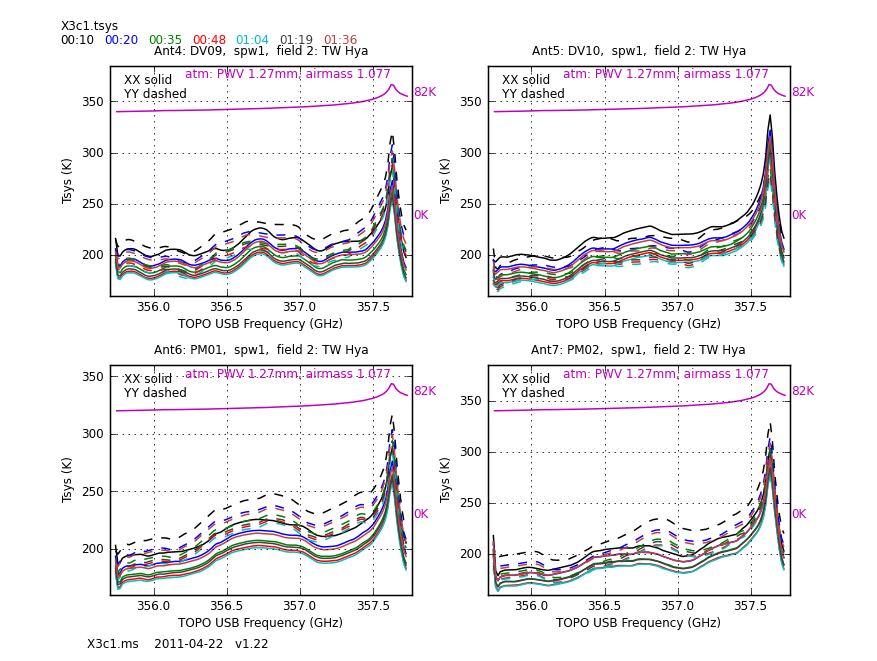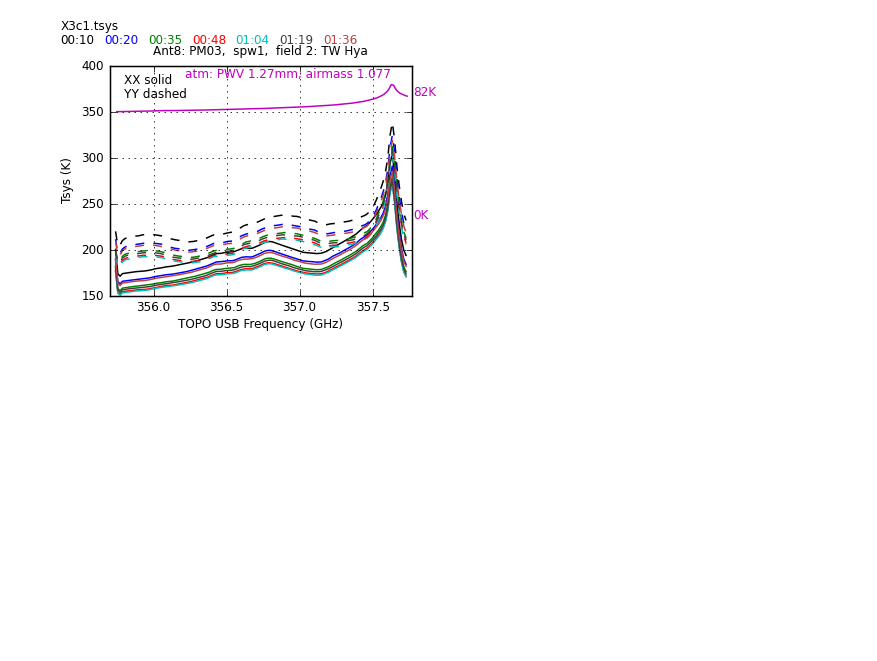TWHydraBand7 SS12: Difference between revisions
No edit summary |
|||
| (One intermediate revision by one other user not shown) | |||
| Line 1: | Line 1: | ||
* '''Overview of the data:''' [[TWHydraBand7_SS12_Overview]] | |||
* '''Imaging portion of the tutorial:''' [[TwHydraBand7_Imaging_SS12]] | |||
[[Category:ALMA]][[Category:Calibration]][[Category:Spectral Line]] | [[Category:ALMA]][[Category:Calibration]][[Category:Spectral Line]] | ||
| Line 452: | Line 455: | ||
<pre style="background-color: #ffa07a;"> | <pre style="background-color: #ffa07a;"> | ||
Remember that we have modified the data somewhat, so that your plots may not exactly resemble those in the guide. They should remain qualitatively similar, however. | Remember that we have modified the data somewhat, so that your plots may not exactly | ||
resemble those in the guide. They should remain qualitatively similar, however. | |||
</pre> | </pre> | ||
Latest revision as of 20:29, 31 May 2012
- Overview of the data: TWHydraBand7_SS12_Overview
- Imaging portion of the tutorial: TwHydraBand7_Imaging_SS12
Preface
An introduction to the source and ALMA observations can be found TWHydraBand7_SS12_Overview. You should review this before beginning the tutorial.
This guide will step you through calibration of ALMA Band 7 observations of TW Hydra. This portion of the guide focuses on the calibration of the data, that is, deriving the the correction for the dependence of phase and amplitude on frequency and time for each antenna and applying a few other fixes. This part of the guide is intended to occupy most of the morning of one tutorial day. You should end this portion of the tutorial with a set of calibrated data ready for imaging. If you do not quite manage to finish, don't worry. We have packaged the full calibrated data set for you so that you can still try imaging in the afternoon.
This particular incarnation of the guide is modified for use at the 13th Synthesis Imaging Summer School (28th - 5th June, 2012). The main modifications from the original CASA guide are:
- We have provided you with only a single Measurement Set, rather than the three in the original guide. Note that we have bundled all three Measurement Sets from the original guide together for you to use in imaging. That is, you will reduce one MS and we will give you two more reduced in a similar way to image.
- We have provided you with a version of the data in which the Tsys and WVR calibrations have already been applied.
- We apply time averaging, increasing the integration time by roughly a factor of 3 (from 10s to 30s), in the split after the application of the Tsys and WVR data.
Notes with a light red background discuss differences between this version of the guide and the full version.
Because we have time-smoothed the data (and made a few other minor modifications to the script compared to the main guide), be warned that the plots you see in the guide may not look exactly like those that appear on your screen.
High Level Overview
This guide will step you through the processing of raw ALMA data into a measurement set consisting of calibrated, correct amplitudes and phases. The key steps are:
- Application of the ALMA online system temperature (Tsys) and water vapor radiometer (WVR) calibrations.
- Derivation of frequency-dependent phase and amplitude corrections for each antenna ("Bandpass Calibration").
- Derivation of time-dependent phase and amplitude corrections for each antenna ("Gain Calibration").
- Identification and removal of problematic data ("flagging").
Along the way you will learn from many examples how to plot your data and derived corrections ("calibration tables"). These steps are absolutely critical to learning to process interferometer data and to gaining an intuitive feel for the flow of data reduction in CASA. Feel encouraged (admonished, even) to experiment with additional plotting and try to look at the data and the effect of each step in as many ways as possible.
We encourage novice users to read through the application of the Tsys and WVR calibrations, but to set them aside until after they have stepped through the main calibration process (we provide a version of the data with these tables already applied). Then come back and step through applying them after you finish the rest of the calibration.
Getting Started
For the Synthesis Imaging school tutorial, we have provided you with the data you will need for this tutorial. The exact location of the data depends on which room you work in, you should have a handout or slide pointing you to the TW Hydra working directory for your machine.
For this portion of the guide change to the directory "ss_twhydra/calibration" and begin work from there. You will find a README file explaining the contents of the directory. These include two forms of the data ("X3c1.ms" and "X3c1_wvrtsys.ms" - read on to understand the difference) and a directory of useful scripts ("analysis_scripts/"). Work on this portion of the guide from inside this directory.
From the "calibration/" directory, begin by starting CASA.
casapy
Note that this guide requires Python module analysisUtils. Test whether these are available inside of CASA (see below) by trying the following:
# In CASA
sys.path.append("analysis_scripts/")
import analysisUtils as au
if it works, you have the analysis_Utilities in the path and may proceed with the guide. The "sys.path.append" call adds the subdirectory "analysis_scripts/" to your path (so that python searches this directory when trying to import a module). If this does not work as for help or refer here: analysisUtils to learn how to retrieve these scripts on your own.
This guide has been written for CASA release 3.4.0. Please confirm your version before proceeding by pasting the following lines of code into your shell:
# In CASA
version = casalog.version()
print "You are using " + version
if (int(version.split()[4][1:-1]) < 19407):
print "\033[91m YOUR VERSION OF CASA IS TOO OLD FOR THIS GUIDE."
print "\033[91m PLEASE UPDATE IT BEFORE PROCEEDING."
else:
print "Your version of CASA is appropriate for this guide."
Once you have verified that you have the right version of CASA and have access to the analysis utilities module, you can are ready to begin.
Observing Log and Priors
Before any calibration, we inspect the data to understand the sequence of observations, spectral setup, what sources were observed, and the purpose of each observation. We examine the basic properties of the data using listobs, which we direct to write its output to a file called 'X3c1.ms.listobs':
# In CASA
os.system('rm X3c1.ms.listobs')
listobs('X3c1.ms', verbose=T, listfile='X3c1.ms.listobs')
You can view the listobs output files using command less from the CASA prompt. Below we copy select parts of the listobs output files for reference.
X3c1.ms:
Data records: 278352 Total integration time = 6109.06 seconds
Observed from 22-Apr-2011/00:01:52.9 to 22-Apr-2011/01:43:42.0 (UTC)
Fields: 5
ID Code Name RA Decl Epoch SrcId nRows
0 none 3c279 12:56:11.16657 -05.47.21.5247 J2000 0 23625
1 none Titan 12:49:25.97588 -02.22.41.3024 J2000 1 4842
2 none TW Hya 11:01:51.84498 -34.42.17.1609 J2000 2 175176
3 none J1147-382=QSO 11:47:01.38151 -38.12.11.1179 J2000 3 14832
4 none J1037-295=QSO 10:37:16.08989 -29.34.02.9888 J2000 4 59877
SpwID #Chans Frame Ch1(MHz) ChanWid(kHz) TotBW(kHz) Corrs
0 4 TOPO 184550 1500000 7500000 I
1 128 TOPO 355740.062 15625 2000000 XX YY
2 1 TOPO 356716.625 1796875 1796875 XX YY
3 128 TOPO 356507.813 15625 2000000 XX YY
4 1 TOPO 357484.375 1796875 1796875 XX YY
5 128 TOPO 346792.187 15625 2000000 XX YY
6 1 TOPO 345784.375 1796875 1796875 XX YY
7 128 TOPO 345182.438 15625 2000000 XX YY
8 1 TOPO 344174.625 1796875 1796875 XX YY
9 128 TOPO 344386.763 15625 2000000 XX YY
10 1 TOPO 343378.95 1796875 1796875 XX YY
11 128 TOPO 346324.263 15625 2000000 XX YY
12 1 TOPO 345316.45 1796875 1796875 XX YY
13 128 TOPO 354402.388 15625 2000000 XX YY
14 1 TOPO 355378.95 1796875 1796875 XX YY
15 128 TOPO 356402.388 15625 2000000 XX YY
16 1 TOPO 357378.95 1796875 1796875 XX YY
17 3840 TOPO 356497.936 122.070312 468750 XX YY
18 1 TOPO 356732.189 468750 468750 XX YY
19 3840 TOPO 357734.314 122.070312 468750 XX YY
20 1 TOPO 357499.939 468750 468750 XX YY
21 3840 TOPO 346034.314 122.070312 468750 XX YY
22 1 TOPO 345799.939 468750 468750 XX YY
23 3840 TOPO 343955.936 122.070312 468750 XX YY
24 1 TOPO 344190.189 468750 468750 XX YY
Antennas: 9:
Name Station Diam. Long. Lat.
0 DV04 J505 12.0 m -067.45.18.0 -22.53.22.8
1 DV06 T704 12.0 m -067.45.16.2 -22.53.22.1
2 DV07 J510 12.0 m -067.45.17.8 -22.53.23.5
3 DV08 T703 12.0 m -067.45.16.2 -22.53.23.9
4 DV09 N602 12.0 m -067.45.17.4 -22.53.22.3
5 DV10 N606 12.0 m -067.45.17.1 -22.53.23.6
6 PM01 T702 12.0 m -067.45.18.6 -22.53.24.1
7 PM02 T701 12.0 m -067.45.18.8 -22.53.22.2
8 PM03 J504 12.0 m -067.45.17.0 -22.53.23.0
Notice that there are a lot of spectral windows! Don't be alarmed. In ALMA data:
- spw=0 is always reserved for the water vapor radiometry data.
- spw=9, 11, 13, 15 are the wideband (TDM) correlator mode with 128 channels per spw default settings for doing pointing and this is all they are used for in these data.
- Currently Tsys data can only be taken in the wide (TDM) correlator mode with 128 channels per spw, these correspond to spws=1, 3, 5, 7 above. The frequencies of these TDM spws were carefully chosen so the narrowband FDM spws fall within them.
- The 0.5 GHz, high spectral resolution spws that contain all the real source data (science target and calibrators) are 17, 19, 21, and 23
- For quicklook purposes, the ALMA online system produces a channel averaged spw for each channelized spw, these correspond to spw=2,4,6,8,10,12,14,16,18,20,22,24 and shouldn't be used for anything in post-processing as bandpass calibration, etc. has not been applied.
In the portion of the listobs output that shows the timerange, the final column gives the scan intent. The scan intent indicates the intended purpose of each scan (e.g., to calibrate the pointing or atmosphere, to calibrate the bandpass, etc.). CASA allows you to select or flag data using by scan intent. For example, you will usually want to flag the CALIBRATE_POINTING* (scans used to ensure that the telescopes are pointing correctly) and CALIBRATE_ATMOS* (hot and cold load measurements used to measure the system teprature) scans. This careful flagging of calibration scans is somewhat less important for this example, because the science data were observed in a different spectral setup than the pointing and atmosphere calibration. Therefore we will be able to easily "split" (separate) out the science data from the rest of the data.
In addition to the science target, Tw Hya, several sources were observed. These will be used as references for calibration, their purposes are:
3c279 is the bandpass calibrator (field id=0) Titan is the absolute flux calibrator (field id=1) J1147-382 is the secondary phase calibrator (field id=3) J1037-295 is the primary phase calibrator (field id=4)
In addition, we know the following information, which might otherwise not be obvious, from the observing logs:
Like at most telescopes, the ALMA operators and astronomers at the site log any significant issues that were noticed from the online system during the observation. For these Band 7 observations of TW Hya on April 22, 2011, the only issue of note was that antenna DV04 could not observe at Band 7 and will need to be flagged.
<figure id="Ant_pos.png">
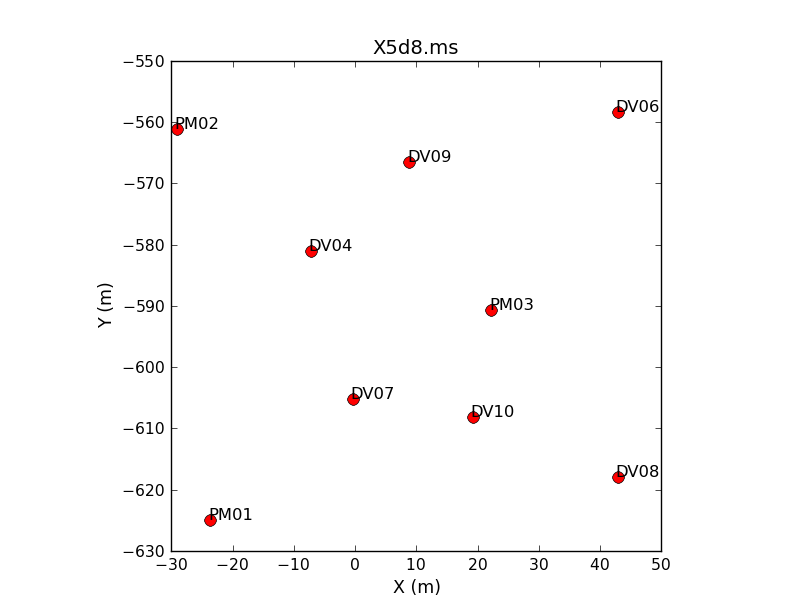
</figure>
Before we move on, its also nice to get an idea where the antennas are with respect to each other. We can use plotants to plot their positions. It is a good idea to check the antenna positions for each measurement set since an antenna may have entered or exited the array between observations.
# In CASA
plotants(vis='X3c1.ms',figfile='X3c1.ms.plotants.png')
You can view the output images using any standard image viewer.
Create the Tsys and WVR Tables, and Examine
The Tsys and WVR calibrations are essential to ALMA's performance. However, these
can also be time consuming to apply. For the summer school we have provided you
with two "starting points:" the 'raw' data ('X3c1.ms') and a version of the data
with the Tsys and WVR already applied ('X3c1_wvrtsys.ms'), some time smoothing applied,
and only the science spectral windows. In the interests of time, we recommend that
you start with the data that already have the WVR and Tsys applied. However, we also
recommend that you read through this section to understand what was done. If you have
time after calibrating the data, try coming back and applying these corrections yourself.
Each ms includes tables that contain the Tsys and WVR measurements associated with the visibility data. In order to apply the corrections derived from these measurements to our data, we must create CASA calibration tables from these measurements.
First we create the WVR calibration tables by running the task wvrgcal. This task examines the water vapor radiometer data for each Measurement Set and creates a calibration table containing phase corrections for each antenna and spectral window.
# In CASA
os.system('rm -rf X3c1.wvr')
wvrgcal(vis='X3c1.ms', caltable='X3c1.wvr', segsource=True, toffset=-1)
Next we create the Tsys calibration tables by running gencal:
# In CASA
os.system('rm -rf X3c1.tsys')
gencal(vis='X3c1.ms', caltable='X3c1.tsys', caltype='tsys')
It is very important that Tsys measurements taken as close in time and elevation as possible to a particular source are applied. To save telescope time, Tsys measurements are sometimes intentionally skipped in the scheduling block for specific sources. So the first step is to establish which sources have their own Tsys measurements and which do not. To do this, you may use the intent parameter of listobs:
# In CASA
listobs(vis='X3c1.ms', verbose=F, selectdata=True, intent='CALIBRATE_ATMOS*')
Fields: 4 ID Code Name RA Decl Epoch SrcId nRows 0 none 3c279 12:56:11.16657 -05.47.21.5247 J2000 0 1116 1 none Titan 00:00:00.00000 +00.00.00.0000 J2000 1 1125 2 none TW Hya 11:01:51.84498 -34.42.17.1609 J2000 2 6795 4 none J1037-295=QSO 10:37:16.08989 -29.34.02.9888 J2000 4 6777 Spectral Windows: (9 unique spectral windows and 2 unique polarization setups) SpwID #Chans Frame Ch1(MHz) ChanWid(kHz) TotBW(kHz) Corrs 0 4 TOPO 184550 1500000 7500000 I 1 128 TOPO 355740.062 15625 2000000 XX YY 2 1 TOPO 356716.625 1796875 1796875 XX YY 3 128 TOPO 356507.813 15625 2000000 XX YY 4 1 TOPO 357484.375 1796875 1796875 XX YY 5 128 TOPO 346792.187 15625 2000000 XX YY 6 1 TOPO 345784.375 1796875 1796875 XX YY 7 128 TOPO 345182.438 15625 2000000 XX YY 8 1 TOPO 344174.625 1796875 1796875 XX YY
Because field '3' (the secondary phase calibrator) does not appear in the list, it has no tsys. Since the secondary phase calibrator is close on the sky to the primary phase calibrator and observed near in time, we will transfer the Tsys from the primary to the secondary phase calibrator. Also notice that spws 1,3,5,7 are the only multi-channel spws that contain Tsys data. At present, Tsys measurements can only be obtained with TDM spectral setups (128 channels/dual pol). Because our science target is observed in FDM (3840 channels/dual pol), we will need to interpolate the measurements from TDM to FDM. But first, to inspect the Tsys vs. time, we use plotcal:
# In CASA
os.system('mkdir cal_plots; mkdir cal_plots/Tsys_plots')
print "Plotting Tsys vs. time for X3c1"
plotcal(caltable='X3c1.tsys', xaxis='time',yaxis='tsys',
antenna='1~8',plotrange=[0,0,100,500],
iteration='antenna',subplot=421,poln='',spw='1:50~50',
figfile='cal_plots/Tsys_plots/X3c1.tsys_vs_time.png')
-
Tsys vs. time for spw 1 of the X3c1.ms data
To inspect Tsys vs. frequency, we use plotbandpass from analysis_Utilities. (Note: You need to have installed analysis_Utilities before starting casapy as explained at the start of this guide.) There are many different options for plotbandpass, and we demonstrate some of the most useful ones. The option showtsky=T will overlay the effective temperature curve from the atmospheric model. This shows us the location of any atmospheric lines which will appear as emission lines in the autocorrelation data (from which the Tsys spectra are derived) from all antennas.
for spw in [1,3,5,7]:
for field in ['0','1']:
au.plotbandpass(caltable='X3c1.tsys', xaxis='freq',yaxis='amp',
showtsky=T,subplot=421,field=field,
spw=spw, interactive=False, plotrange=[0,0,0,0],
figfile='cal_plots/Tsys_plots/X3c1.tsys.field%s.png'%field,
buildpdf=False)
Here we see the effect of atmospheric ozone lines on the Tsys measurements associated with 3C279 in spw 1 and 3.
-
Tsys vs. frequency on 3C279 for the X3c1.ms data, spw=1
-
Tsys vs. frequency on 3C279 for the X3c1.ms data, spw=3
For sources that have multiple Tsys measurements (typically the primary phase calibrator and/or the science target) one can use overlay="time" to overlay all the measurements for that source. This can help to identify any anomalous Tsys scans. As a fraction of the plots produced by this loop, here we show the Tsys recorded on spw=1 for TW Hya from the first dataset.
for spw in [1,3,5,7]:
for field in ['2','4']:
au.plotbandpass(caltable='X3c1.tsys', xaxis='freq',yaxis='amp',
showtsky=T,subplot=221,field=field,
overlay='time',spw=spw, interactive=False, plotrange=[0,0,0,0],
figfile='cal_plots/Tsys_plots/X3c1.tsys.field%s.png'%field,
buildpdf = False)
-
Tsys vs. freq for field 2, spw 1 of the X3c1.ms data (antennas 0..3)
-
Tsys vs. freq for field 2, spw 1 of the X3c1.ms data (antennas 4..7)
-
Tsys vs. freq for field 2, spw 1 of the X3c1.ms data (antenna 8)
Alternatively, the overlay="antenna" option will quickly reveal any Antennas with discrepant Tsys values, as they will be obvious outliers. For FDM projects like this one, using the showfdm=True option can be helpful, as it will show where in the TDM bandpass each FDM spw was located. <figure id="X3c1.tsys.field0.spw1.t1.png">
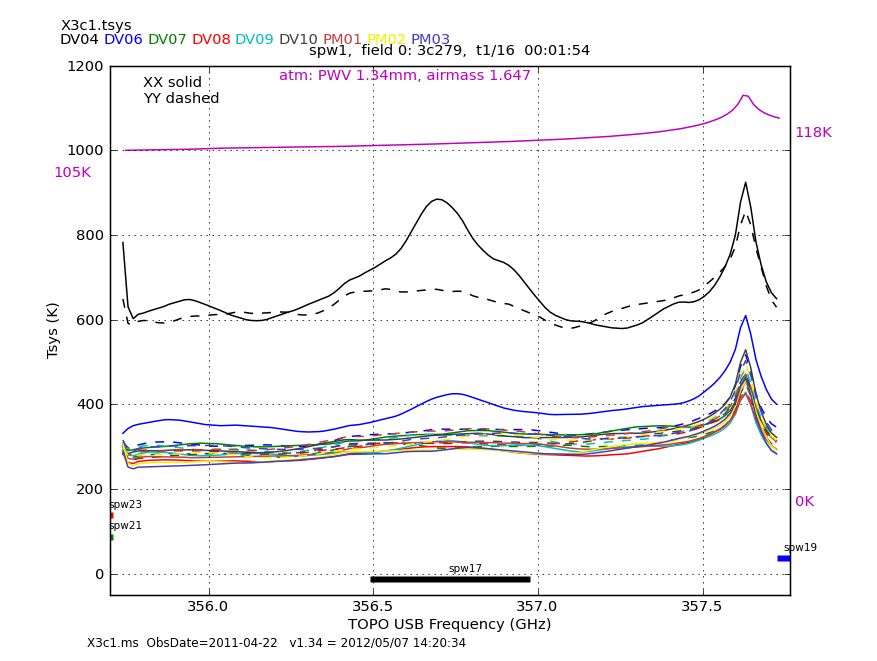
</figure>
tsysfields=['0','1','2','4']
for spw in [1,3,5,7]:
for field in tsysfields:
au.plotbandpass(caltable='X3c1.tsys', xaxis='freq',yaxis='amp',
showtsky=T,subplot=111,field=field,
overlay='antenna',spw=spw, interactive=False,
figfile='cal_plots/Tsys_plots/X3c1.tsys.field%s.png'%field,
buildpdf=False,showfdm=True)
Note that DV04 consistently has a significantly higher Tsys than the rest of the antennas. We already know from the Observation log that
we need to flag that antenna, but had we not had that information, examining this plot would have demonstrated the situation.
Apply the Tsys and WVR Tables, and Split
Next we apply the calibrations. For the (4) sources with Tsys measurements, we use the field and gainfield parameters of applycal to apply solutions only to themselves. We also tell casa to interpolate the TDM Tsys values in spws 1,3,5,7 onto the FDM spws 17,19,21,23 using the spwmap parameter. While applying Tsys, we will also apply the wvr calibration tables; wvr data is usually always present for all sources. Below we first set some definitions so we can loop over the correct parameters:
# In CASA
fdm='17,19,21,23'
nocal='3' # This source had no Tsys measurements associated with it
tsysfields=['0','1','2','4']
tsysmap = range(25)
tsysmap[17] = 1
tsysmap[19] = 3
tsysmap[21] = 5
tsysmap[23] = 7
for field in tsysfields:
applycal(vis='X3c1.ms', spw=fdm, field=field, gainfield=field,
gaintable=['X3c1.tsys', 'X3c1.wvr'], spwmap=[tsysmap,[]],
interp=['linear,spline','nearest'], flagbackup=F)
For the sources without Tsys (i.e. field=3), couple them with the best available source with Tsys (i.e. field=4).
# In CASA
applycal(vis='X3c1.ms', spw=fdm, field=nocal,
gaintable=['X3c1.tsys', 'X3c1.wvr'], spwmap=[tsysmap,[]],
gainfield=['4',nocal], interp=['linear,spline','nearest'],flagbackup=F)
Check Tsys application with plotms. First we make plots with ydatacolumn='data' to look at the raw data. For simplicity we'll just look at the two strongest sources 3C279 and Titan.
<figure id="X3c1_wvrtsys_corrected_spw19.png">
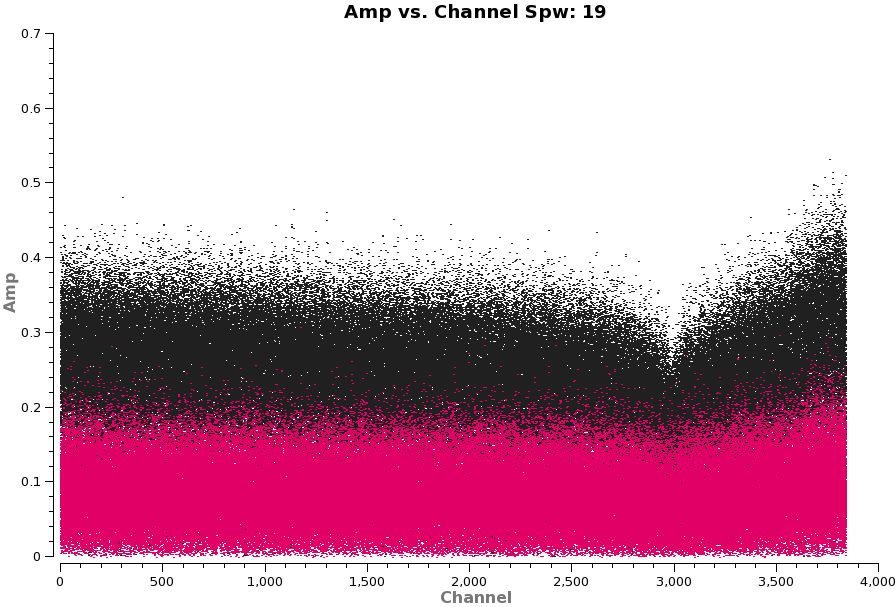
</figure>
# In CASA
plotms(vis='X3c1.ms',spw='17,19,21,23',xaxis='frequency',yaxis='amp',field='0,1',
antenna='*&*',avgtime='1e8',avgscan=T,coloraxis='field',iteraxis='spw',
xselfscale=T,ydatacolumn='data')
<figure id="X5d8_wvrtsys_corrected_spw21.png">
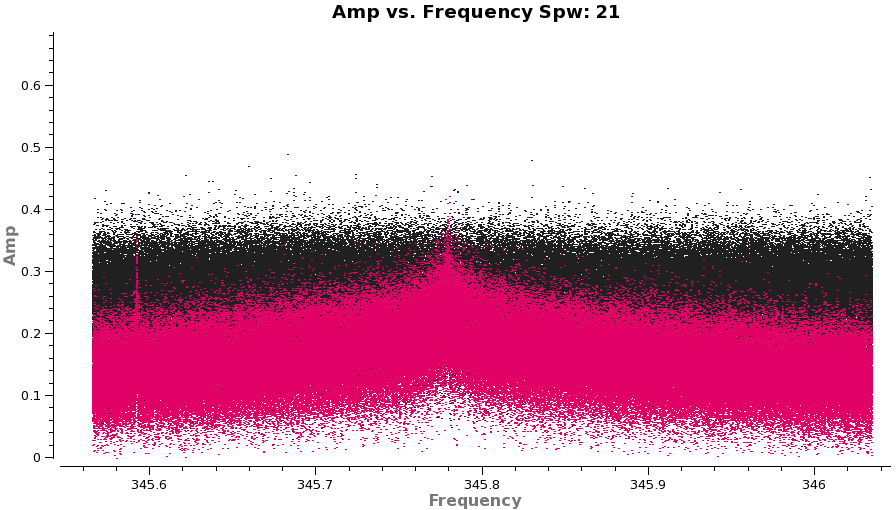
</figure>
Note: the antenna='*&*' is specifying that we only want to see the cross-correlation data (i.e. not the autocorrelations).
Use the green arrows on the plotms display to cycle through the 4 FDM spws.
Now change Data Column to corrected on the "Axes" tab (this is the same as ydatacolumn in the task) and hit Plot button on the GUI. Flip through again.
Things to notice:
- The amplitude scale has changed due to application of Tsys
- spw=17 is clean and flat
- spw=19 shows a strong dip around channel 3000 -- this is an atmospheric ozone absorption feature at 357.6 GHz. In the future, high spectral resolution Tsys measurements may help to remove the shape of the absorption, but until then we will need to flag this part of the spectrum.
- spw=21 Titan shows both a narrow and a broad spectral feature. The broad feature is CO(3-2) and it completely fills the 0.5 GHz band so there are no line-free channels! Titan must be handled carefully when it is used as a calibrator because it contains strong line emission. Indeed, we will not be able to use the absolute flux transfer from this spw for other targets. When possible Titan should be avoided for absolute flux calibration. For these observations, no other suitable absolute flux calibrator was available.
- spw=23 shows another strong line from Titan.
Beyond these things to notice, the application of Tsys and wvr seem to have gone well. We can now split off only the narrow band FDM spectral windows for further processing.
Note that in order to ensure that the tutorial runs quickly we have included time-averaging in the following split command (via timebin='30s'). It is important that this time-averaging is applied *after* application of the WVR calibration (which contain corrections on timescales shorter than 30 seconds). Also, note that by doing this, we sacrifice the ability to derive any calibrations on timescales shorter than 30 seconds. We also might lose some accuracy in the imaging due to a changing u-v projection as the baseline rotates. Neither of these concerns will be critical for these data.
# In CASA
newvis = 'X3c1_wvrtsys.ms'
os.system('rm -rf ' + newvis)
split(vis='X3c1.ms',outputvis=newvis,datacolumn='corrected',timebin='30s',spw=fdm)
Note: After split, the spectral windows will be renumbered to 0, 1, 2, 3 corresponding to the old spw=17, 19, 21, 23, see listobs excerpt below.
SpwID #Chans Frame Ch1(MHz) ChanWid(kHz) TotBW(kHz) Corrs 0 3840 TOPO 356497.936 122.070312 468750 XX YY 1 3840 TOPO 357734.314 122.070312 468750 XX YY 2 3840 TOPO 346034.314 122.070312 468750 XX YY 3 3840 TOPO 343955.936 122.070312 468750 XX YY
Initial Inspection and Flagging
From here we begin to operate on the *wvrtsys.ms files.
If you chose (as recommended) to start with the WVR and tsys applied, begin the hands-on tutorial here.
Before we begin flagging data, we unflag all data in the measurement sets. If this is your first pass through this section of the guide, no data in the measurement sets will be flagged, and you can skip this step. If you are rerunning the flagging commands below, this will reset your flag columns to their original state. (Warning messages about using task tflagdata can be ignored for now.)
# In CASA
flagdata(vis='X3c1_wvrtsys.ms', mode='manualflag', unflag=T, flagbackup=F)
ALMA data contains both the cross correlation and autocorrelation data. Presently nothing more can be done with the autocorrelation data so we flag it. Additionally, for smaller configurations of the array, and for northerly sources, one antenna can shadow another, blocking its view. These data also need to be flagged. Finally, the observing log reported that DV04 was not behaving properly at Band 7 and shouldn't be used, so we flag that as well.
# In CASA
flagdata(vis='X3c1_wvrtsys.ms',autocorr=True, flagbackup=T)
flagdata(vis='X3c1_wvrtsys.ms',mode='shadow',diameter=12.0, flagbackup=F)
flagdata(vis='X3c1_wvrtsys.ms',antenna='DV04', flagbackup=F)
Next we inspect the data with plotms for additional issues that need flagging, first looking at amplitude vs. time. Use the green arrows on the plotms GUI to cycle through spws.
<figure id="Tsyswvr_time_spw0_X3x1.png">

</figure>
Note: when iteraxis is invoked in plotms, unzoom does not always work properly. If you have trouble with this, flip to next page and then back to current one. This usually fixes the problem.
# In CASA
plotms(vis='X3c1_wvrtsys.ms',spw='',xaxis='time',yaxis='amp',field='',avgchannel='3840',
coloraxis='field',iteraxis='spw')
Remember that we have modified the data somewhat, so that your plots may not exactly resemble those in the guide. They should remain qualitatively similar, however.
<figure id="Tsyswvr_time_spw2corr_X3x1.png">
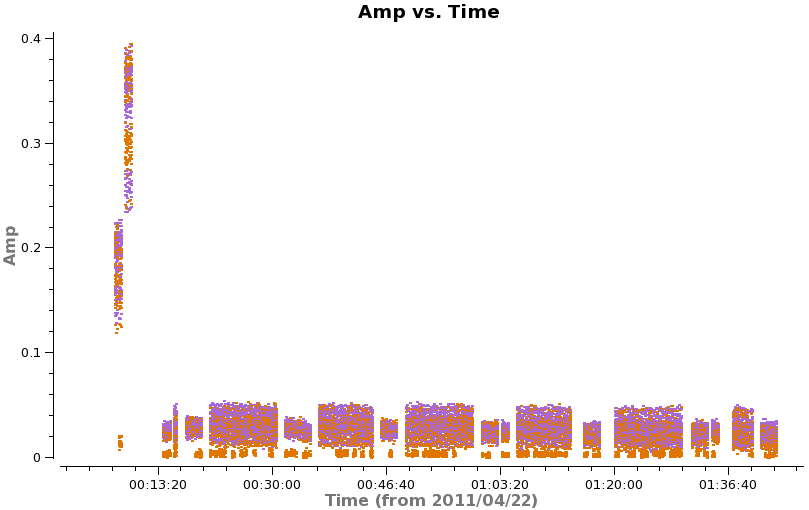
</figure>
Things to Notice:
- There are some low points in spw=2. Use the "Mark Regions" box (left of center on bottom row of icons) to draw a small box around the low points. Then click the magnifying glass ("Locate") icon to the right of center. The output will be sent to the logger window. Note: keep the marked region small or you can overwhelm the buffer. Locate suggests correlation YY on PM03 is the culprit.
To see this more clearly you can rerun plotms with coloraxis='field' switched to coloraxis='corr'
# In CASA
plotms(vis='X3c1_wvrtsys.ms',spw='2',xaxis='time',yaxis='amp',field='',avgchannel='3840',
coloraxis='corr')
To further check, you can exclude PM03 from the plot using antenna='!PM03'.
# In CASA
plotms(vis='X3c1_wvrtsys.ms',spw='2',xaxis='time',yaxis='amp',field='',avgchannel='3840',
coloraxis='corr',antenna='!PM03')
Having confirmed the problem antenna, we flag it below.
# In CASA
flagdata(vis='X3c1_wvrtsys.ms', flagbackup=T,
spw=['2'],
antenna=['PM03'],
correlation=['YY'])
Next we need to inspect the spectral properties of the data to look for issues.
First we look at phase as a function of frequency for a well behaved antenna like DV06. coloraxis='baselines' (note this parameter is called Colorize in the GUI "Display" tab) will show each baseline as a different color. Significant delay errors or baseline errors will show up as phase slopes in these plots. Again you will want to page through the spectral windows.
# In CASA
plotms(vis='X3c1_wvrtsys.ms',spw='',xaxis='frequency',yaxis='phase',field='0',antenna='DV06',
avgtime='1e8',avgscan=T,coloraxis='baseline',iteraxis='spw',xselfscale=T)
Overall these plots look good with no large delays or baseline errors apparent.
<figure id="Birdies_spw2_X3x1.png">
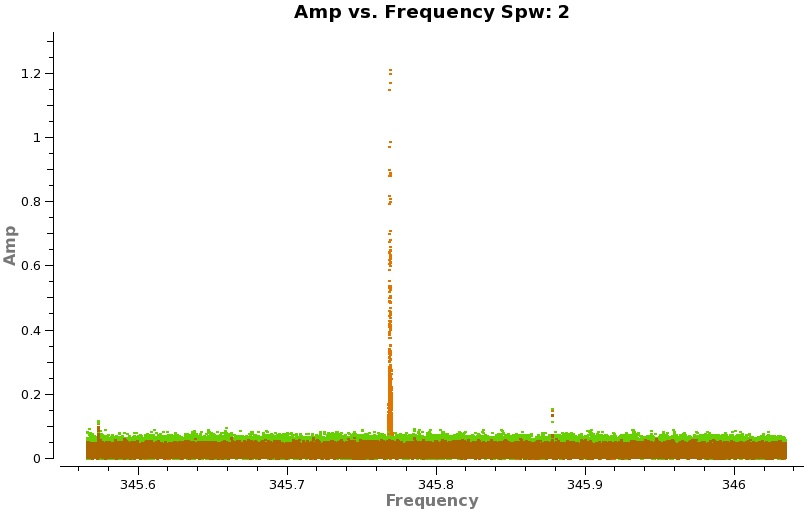
</figure>
With such high spectral resolution data, one often sees occasional "birdies" in the data. These are typically very narrow weak spectral features that are internally generated in the system. Over time as we track down issues the number of birdies should decrease, but you should always check. This is easiest to do by looking at amplitude vs. frequency for sources observed over a long time range (for sensitivity). It is helpful to look at more than one source to verify the nature of the emission. Below we look at both calibrators (brown and green) and TW Hya (orange). If you have enough sensitivity birdies should be seen on all sources, however, be careful not to mistake real line emission for a birdie even on a calibrator - they can be present as we've seen for Titan.
<figure id="Birdies_spw3_X3x1.png">
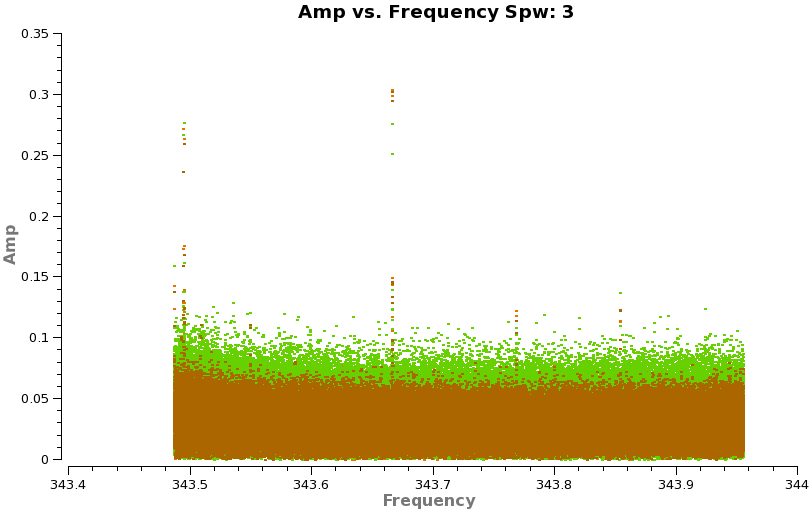
</figure>
# In CASA
plotms(vis='X3c1_wvrtsys.ms',spw='',xaxis='channel',yaxis='amp',field='2,3,4',
avgtime='1e8',avgscan=T,coloraxis='field',iteraxis='spw',xselfscale=T,yselfscale=T)
Now you can zoom in on each region to get channels for flagging, or to save time just go ahead and run the flagging command below where this has been done for you.
# In CASA
flagdata(vis='X3c1_wvrtsys.ms', flagbackup=T,
spw=['0:1067~1068;1279~1280;2367~2368;3775~3776',
'1:1279~1280;2367~2368;3775~3776',
'2:1279~1280;3775~3776',
'3:831~832;1535~1536;2367~2368;3775~3776;3839~3839'])
Replot in plotms to check that flagging has been done as anticipated.
Flag Calibrator Spectral Features
In this section, we will flag spectral features in the calibrators so they do not skew the calibration solutions. First make plots of 3C279 and Titan in channel space to get channels for flagging.
<figure id="3C279_Titan_spw1.png">
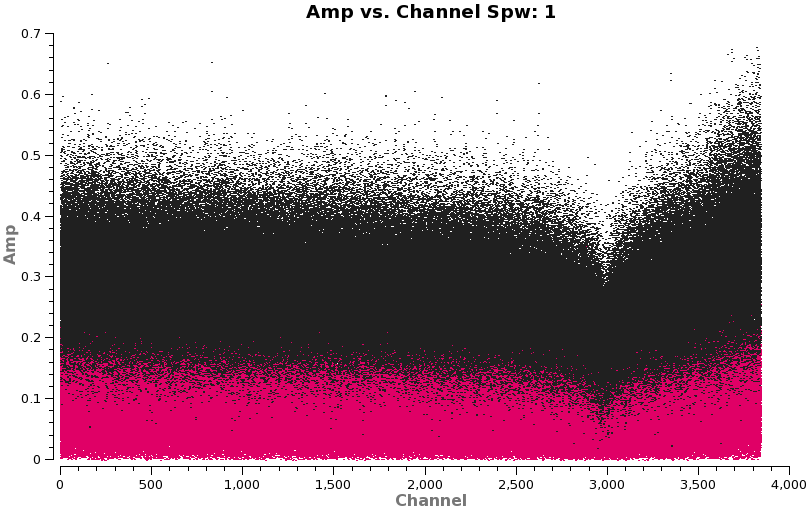
</figure> <figure id="Figure10.jpg">

</figure> <figure id="Figure11.jpg">

</figure>
# In CASA
plotms(vis='X3c1_wvrtsys.ms',spw='',xaxis='channel',yaxis='amp',field='0,1',
avgtime='1e8',coloraxis='field',iteraxis='spw')
The figure to the right shows a broad absorption line in spw 1 at channel 3000. This is the ozone absorption line at 357.62982 GHz. However, there is another narrow absorption feature in the spectra (spw 2) that is most easily seen on 3C279 (because it is the strongest calibrator). Let's look at it first in frequency space.
# In CASA
plotms(vis='X3c1_wvrtsys.ms',spw='2:1600~2300',xaxis='frequency',yaxis='amp',
field='0',avgtime='1e8',coloraxis='field')
The absorption feature lies exactly at the rest frequency for CO 3-2 (345.79599 GHz). Because it is so narrow (< 1 MHz), it must originate from a very low pressure region (i.e. high altitude) in the Earth's atmosphere, otherwise it would be more pressure-broadened. Indeed, the first detection of CO in the mesosphere was made over 35 years ago (see, e.g. Waters et al. 1976 or Goldsmith et al. 1979). Be aware that the line is stronger as you go up the CO ladder (strength ~ J^3 for low J) because the temperature at that altitude (~50km) is about 250 K. In April 2011, the apparent depth of the feature was about 10% in the 2-1 line and 35% in the 3-2 line. However, the depth of the absorption feature is exaggerated due to the way ALMA normalizes the cross-correlation spectra by the autocorrelation spectra prior to storage. While this technique generally leads to a flat bandpass shape, it will accentuate telluric features because they are emission lines in the single dish spectrum (e.g. JCMT observations of mesospheric CO 3-2 can be found in Preston et al. 1993). Finally, note that large seasonal variations in the line strength have been reported from observations at Onsala.
Now, let's re-plot the line with channel number as the x-axis in order to get the channel range for flagging.
# In CASA
plotms(vis='X3c1_wvrtsys.ms',spw='2:1600~2300',xaxis='channel',yaxis='amp',
field='0',avgtime='1e8',coloraxis='field')
Now lets look at Titan in more detail.
# In CASA
plotms(vis='X3c1_wvrtsys.ms',spw='',xaxis='channel',yaxis='amp',field='1',
avgtime='1e8',coloraxis='field',iteraxis='spw')
Before we begin flagging, you want to explicitly back up the flag tables so that flagged regions can be restored later. To do this, we use flagmanager.
# In CASA
flagmanager(vis='X3c1_wvrtsys.ms',mode='save',versionname='X3c1_wvrtsys.before_calspectralflags')
<figure id="Titan_spw2.png">
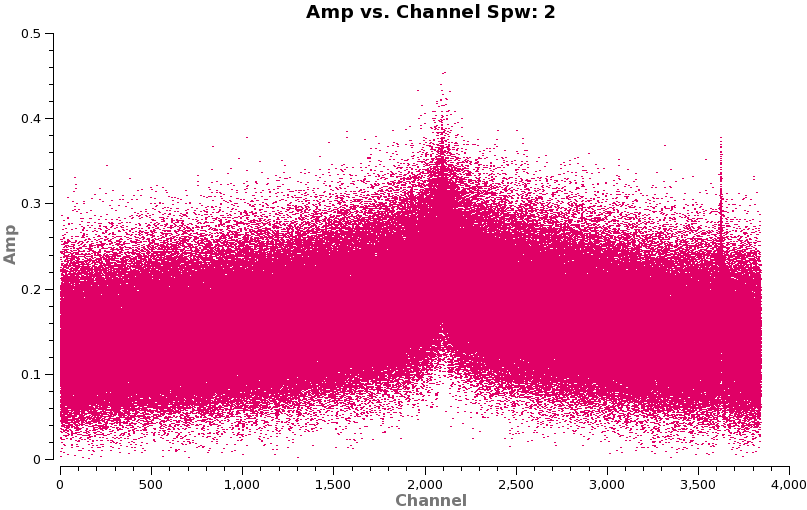
</figure>
Flag absorption features for all sources.
# In CASA
flagdata(vis='X3c1_wvrtsys.ms', spw=['1:2000~3840','2:1945~1960'])
<figure id="Titan_spw3.png">
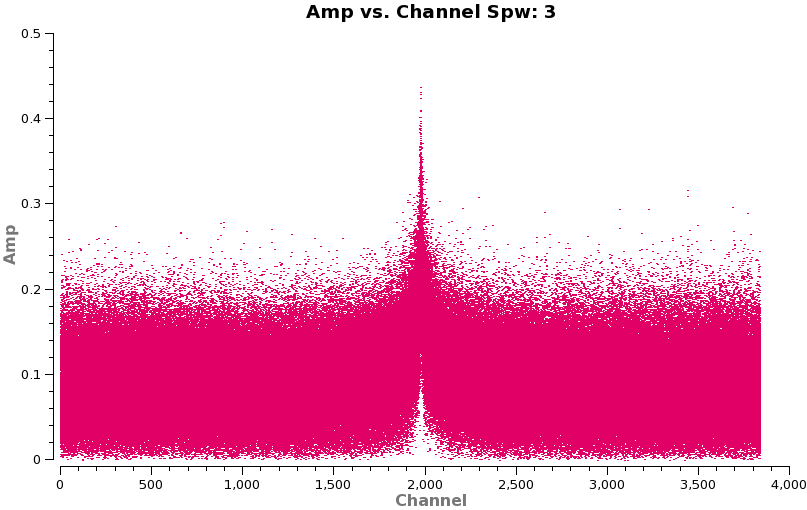
</figure>
Now we need to flag emission.
The very broad CO(3-2) in spw=2 of Titan will prevent us from using it as a calibrator for this spectral window since there are no line-free channels (we will transfer, phase, amplitude, and absolute flux from another Titan spw below). We do want to flag the narrower Titan line in spw=3.
# In CASA
flagmanager(vis='X3c1_wvrtsys.ms',mode='save',versionname='X3c1_wvrtsys.before_emissionflags')
# In CASA
flagdata(vis='X3c1_wvrtsys.ms',
field=['1'],
spw=['3:1000~3000'])
If you like, check that the right things have been flagged.
# In CASA
plotms(vis='X3c1_wvrtsys.ms',spw='',xaxis='channel',yaxis='amp',field='0,1',
avgtime='1e8',coloraxis='field',iteraxis='spw')
Set Up the Flux Calibrator Model
Fill the model data column for Titan with a model for the flux density as a function of baseline. The model is a uniformly illuminated disk with the size obtained from the JPL Horizons ephemeris.
# In CASA
setjy(vis='X3c1_wvrtsys.ms',field='1',
standard='Butler-JPL-Horizons 2010',scalebychan=F)
<figure id="Titan amp vs uvdist.png">
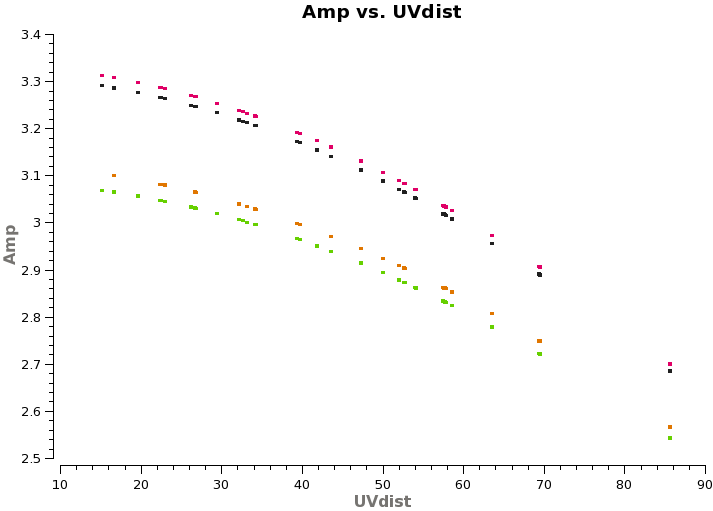
</figure>
After running setjy, it is a good idea to plot the model in order to confirm that it makes sense. In this case, Titan is partially resolved, so we expect the flux density to drop with uv distance, but not so much as to pass through a null. We also expect it to be brighter at higher frequencies since it has a thermal blackbody spectrum.
# In CASA
plotms(vis='X3c1_wvrtsys.ms',field='1',xaxis='uvdist',yaxis='amp',coloraxis='spw',
ydatacolumn='model')
Bandpass Calibration
First we need to check how the amplitude and phase of 3C279 behave as a function of time. In order to set a fixed scale on the y-axis, we first make a plot of all the data, excluding antenna DV04. (We must specify ydatacolumn='data' explicitly here because the default value of ydatacolumn equals the value used in the previous execution of plotms. In the previous execution ydatacolumn was set to model. See the online help, help plotms, for details.)
# In CASA
plotms(vis='X3c1_wvrtsys.ms',xaxis='time',yaxis='amp',coloraxis='corr',
field='0',avgchannel='3840',ydatacolumn='data')
<figure id="Figure15.jpg">

</figure>
We see that the uncalibrated amplitudes range between 0.2-0.4, so let's set this as our scale and examine a representative baseline (DV06-DV07) to see how the amplitude changes with time.
for spw in ['0','1','2','3']:
print "Now showing spw %s " % (spw)
plotms(vis='X3c1_wvrtsys.ms',spw=spw,xaxis='time',yaxis='amp',coloraxis='corr',iteraxis='spw',
field='0',avgchannel='3840',antenna='DV06&DV07',plotrange=[0,0,0.2,0.4])
user_check=raw_input('press enter to go to the next plot\n')
<figure id="Figure16.jpg">

</figure>
Page through the measurement sets for each spw. Here, it is important to remember that earlier we applied time averaging to increase the integration time from 10s to 30s. It will be difficult to notice significant variations with only two points. However, there are significant variations in the amplitude across the measurement set.
Now, we do the same with phase.
# In CASA
for spw in ['0','1','2','3']:
plotms(vis='X3c1_wvrtsys.ms',spw=spw,xaxis='time',yaxis='phase',coloraxis='corr',iteraxis='spw',
field='0',avgchannel='3840',antenna='DV06&DV07',plotrange=[0,0,-180,180])
user_check=raw_input('press enter to go to the next plot\n')
Again, we only have two points but examination of this data reveals small (but significant) variations within the scan. To correct for the small variations within the scan, we need to correct the phase vs. time behavior of the bandpass calibrator (3C279; field=0) before doing the bandpass. We want to choose a relatively narrow range of channels near the center of the spws so that the bandpass phase slopes (to be corrected with the bandpass calibration itself) do not decorrelate the signal. You need to avoid spectral regions that were completely flagged above.
# In CASA
gaincal(vis='X3c1_wvrtsys.ms',caltable='X3c1_wvrtsys.bpphase.gcal',
field='0',spw='0~3:900~1100',refant='DV06',
calmode='p',solint='int',minsnr=2.0,minblperant=4)
While you are only looking at one MS here, there is significant variation in the phase across the 3 scans of 3c279 of the 3 different measurement sets. This finding would suggest that we would not want to combine the scans for bandpass calibration, but instead derive an independent bandpass for each scan, which is what was done for the measurement set you will be provided for imaging.
<figure id="Figure17.png">

</figure>
Inspect the phase-only calibration solutions for the bandpass calibrator. Look for any noisy solutions. We do XX and YY separately to reduce confusion in the plot. It will help if you make your plotcal window wide.
# In CASA
plotcal(caltable='X3c1_wvrtsys.bpphase.gcal',xaxis='time',yaxis='phase',spw='',antenna='1~8',
iteration='antenna',subplot=421,plotrange=[0,0,-180,180],
figfile='X3c1_wvrtsys.bpphase.X.png',poln='X')
In the plotcal GUI you can use the magnifying glass symbol to zoom in on one of the scans to see the phase variations. The colors are the 4 different spws.
# In CASA
plotcal(caltable='X3c1_wvrtsys.bpphase.gcal',xaxis='time',yaxis='phase',spw='',antenna='1~8',
iteration='antenna',subplot=421,plotrange=[0,0,-180,180],
figfile='X3c1_wvrtsys.bpphase.Y.png',poln='Y')
Next we apply this phase-only correction on-the-fly while calculating the bandpass solutions.
# In CASA
bandpass(vis='X3c1_wvrtsys.ms',caltable='X3c1_wvrtsys.bandpass.bcal',
field='0',spw='',combine='',refant='DV06',
solint='inf',solnorm=T,minblperant=4,fillgaps=17,
gaintable=['X3c1_wvrtsys.bpphase.gcal'])
You will see some error messages in the terminal, these are just related to the flagged channels. We set fillgaps=17 to interpolate across the smaller regions of flagged channels (mesospheric features and birdies).
<figure id="Figure18.png">
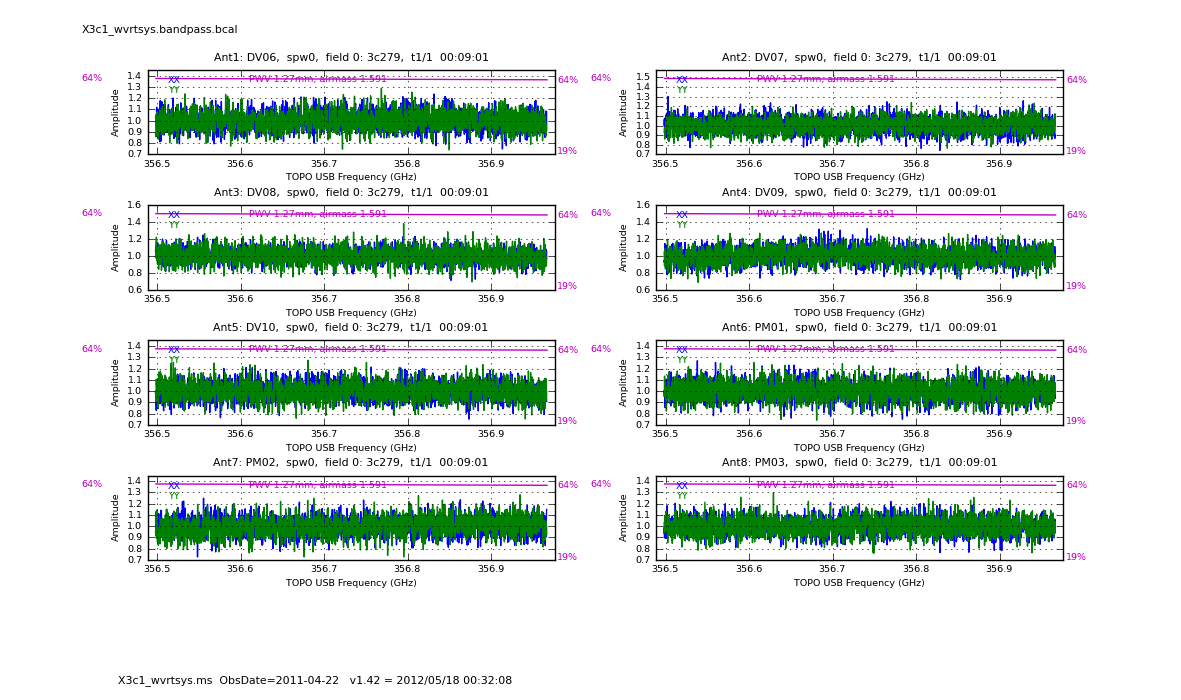
</figure> <figure id="Figure19.png">
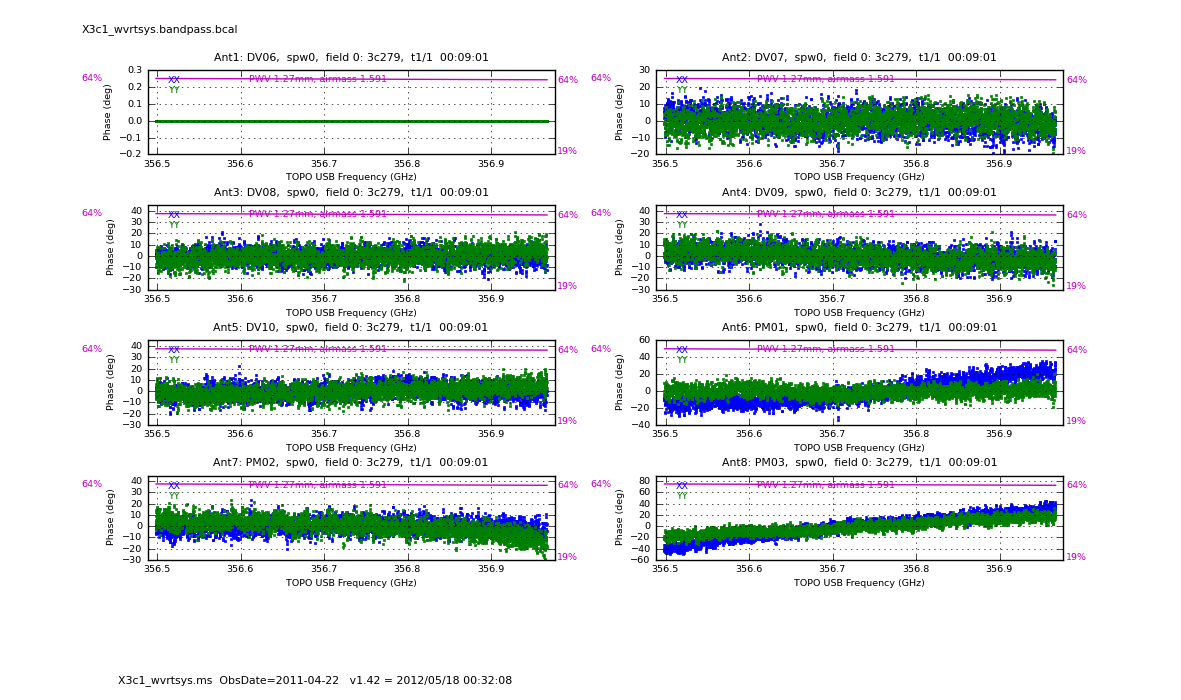
</figure>
A few words about solint and combine:
In bandpass the use of solint='inf' (as in "infinite") would derive a bandpass solution for each 3C279 scan if we were working with all three measurement sets, unless combine='scan' (which is the default) . Here we set combine=' ' explicitly so that it does not combine the scans into one bandpass. Likewise, field boundaries are only crossed if combine='field', and spw boundaries are only crossed if combine='spw'. In some cases it can be helpful to combine fields if you suffer from lack of S/N, but it is never a good idea to combine spws.
Now inspect the phase and amplitude solutions. You are looking for excursions from smooth fits, or particularly noisy solutions compared to the others.
# In CASA
for spw in [0,1,2,3]:
au.plotbandpass('X3c1_wvrtsys.bandpass.bcal',xaxis='freq',yaxis='amp', spw=spw,
antenna='1~8', subplot=421, figfile='X3c1_wvrtsys.bandpass.amp', showatm=T,
interactive=True)
user_check=raw_input('press enter to go to the next plot\n')
# In CASA
for spw in [0,1,2,3]:
au.plotbandpass('X3c1_wvrtsys.bandpass.bcal',xaxis='freq',yaxis='phase',spw=spw,
antenna='1~8',subplot=421,figfile='X3c1_wvrtsys.bandpass.phs', showatm=T,
interactive=True)
user_check=raw_input('press enter to go to the next plot\n')
The values of phase on DV06 are very close to zero because it was used as the reference antenna.
Gain Calibration
Now that we have a bandpass solution to apply we can solve for the antenna-based phase and amplitude gain calibration. Since the phase changes on a much shorter timescale than the amplitude, we will solve for them separately. In particular, if the phase changes significantly over a scan time, the amplitude would be decorrelated, if the un-corrected phase were averaged over this timescale. Note that we re-solve for the gain solutions of the bandpass calibrator, so we can derive new solutions that are corrected for the bandpass shape. Since the bandpass calibrator will not be used again, this is not strictly necessary, but is useful to check its calibrated flux density for example.
# In CASA
gaincal(vis='X3c1_wvrtsys.ms',caltable='X3c1_wvrtsys.intphase.gcal',
field='0,1,3,4',spw='0~3:40~3800',refant='DV06',
calmode='p',solint='int',minsnr=2.0,minblperant=4,
gaintable=['X3c1_wvrtsys.bandpass.bcal'])
Here solint='int' coupled with calmode='p' will derive a single phase solution for each 30 second integration. Note that the bandpass table is applied on-the-fly before solving for the phase solutions, however the bandpass is NOT applied to the data permanently until applycal is run later on.
Although solint='int' (i.e. the integration time of 30 seconds) is the best choice to apply before solving for the amplitude solutions, it is not a good idea to use this to apply to the target. This is because the phase-scatter within a scan can dominate the interpolation between calibrator scans. Instead, we also solve for the phase on the scan time, solint='inf' (but combine=' ' , since we want one solution per scan) for application to the target later on. Unlike the bandpass task, for gaincal, the default of the combine parameter is combine=' ' .
# In CASA
gaincal(vis='X3c1_wvrtsys.ms',caltable='X3c1_wvrtsys.scanphase.gcal',
field='0,1,3,4',spw='0~3:40~3800',refant='DV06',
calmode='p',solint='inf',minsnr=2.0,minblperant=4,
gaintable=['X3c1_wvrtsys.bandpass.bcal'])
Alternatively, instead of making a separate phase solution for application to the target, one can also run smoothcal to smooth the solutions derived on the integration time.
Next we apply the bandpass and solint='int' phase-only calibration solutions on-the-fly to derive amplitude solutions. Here the use of solint='inf' , but combine=' ' will result in one solution per scan interval.
# In CASA
gaincal(vis='X3c1_wvrtsys.ms',caltable='X3c1_wvrtsys.amp.gcal',
field='0,1,3,4',spw='0~3:40~3800',refant='DV06',
calmode='ap',solint='inf',minsnr=2.0,minblperant=4,
gaintable=['X3c1_wvrtsys.bandpass.bcal','X3c1_wvrtsys.intphase.gcal'])
Now carefully inspect all these solutions looking for discrepant solutions. If you see any, you will need to flag them and rerun the calibration tasks above.
We make plots in X and Y separately for clarity. The colors are showing the spectral windows. <figure id="X3c1_wvrtsys.intphase_X.png">
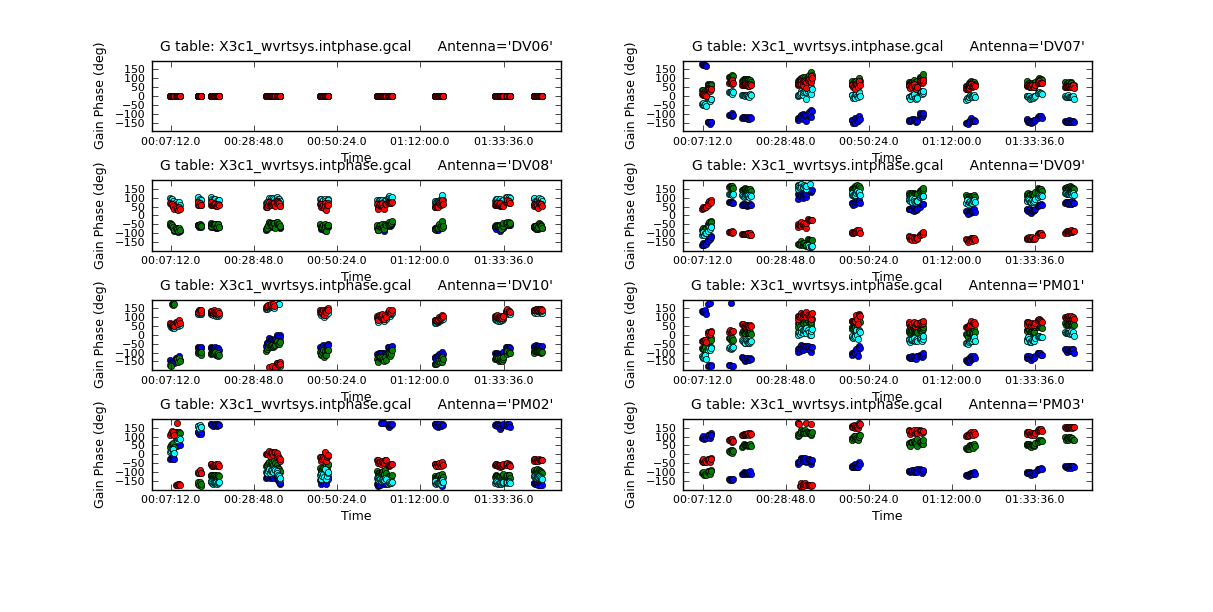
</figure>
# In CASA
plotcal(caltable='X3c1_wvrtsys.intphase.gcal',xaxis='time',yaxis='phase',antenna='1~8',
spw='',field='0,1,3,4',iteration='antenna',subplot=421,
plotrange=[0,0,-180,180],poln='X',figfile='X3c1_wvrtsys.intphase_X.png')
# In CASA
plotcal(caltable='X3c1_wvrtsys.intphase.gcal',xaxis='time',yaxis='phase',antenna='1~8',
spw='',field='0,1,3,4',iteration='antenna',subplot=421,
plotrange=[0,0,-180,180],poln='Y',figfile='X3c1_wvrtsys.intphase_Y.png')
<figure id="X3c1_wvrtsys.scanphase_X.png">
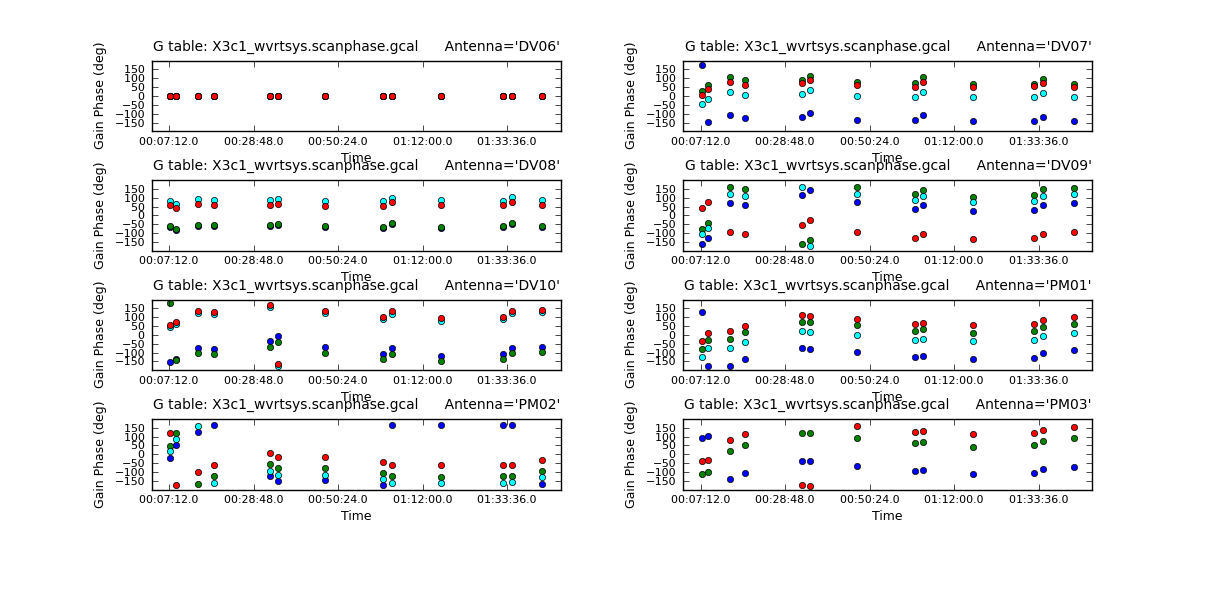
</figure>
# In CASA
plotcal(caltable='X3c1_wvrtsys.scanphase.gcal',xaxis='time',yaxis='phase',antenna='1~8',
spw='',field='0,1,3,4',iteration='antenna',subplot=421,
plotrange=[0,0,-180,180],poln='X',figfile='X3c1_wvrtsys.scanphase_X.png')
# In CASA
plotcal(caltable='X3c1_wvrtsys.scanphase.gcal',xaxis='time',yaxis='phase',antenna='1~8',
spw='',field='0,1,3,4',iteration='antenna',subplot=421,
plotrange=[0,0,-180,180],poln='Y',figfile='X3c1_wvrtsys.scanphase_Y.png')
Since we have taken out the phase as best we can by applying the solint='int' phase-only solution, this plot will give a good idea of the residual phase error. If you see scatter of more than a few degrees here, you should consider going back and looking for more data to flag, particularly bad timeranges etc.
<figure id="X3c1_wvrtsys.amp_phase.png">
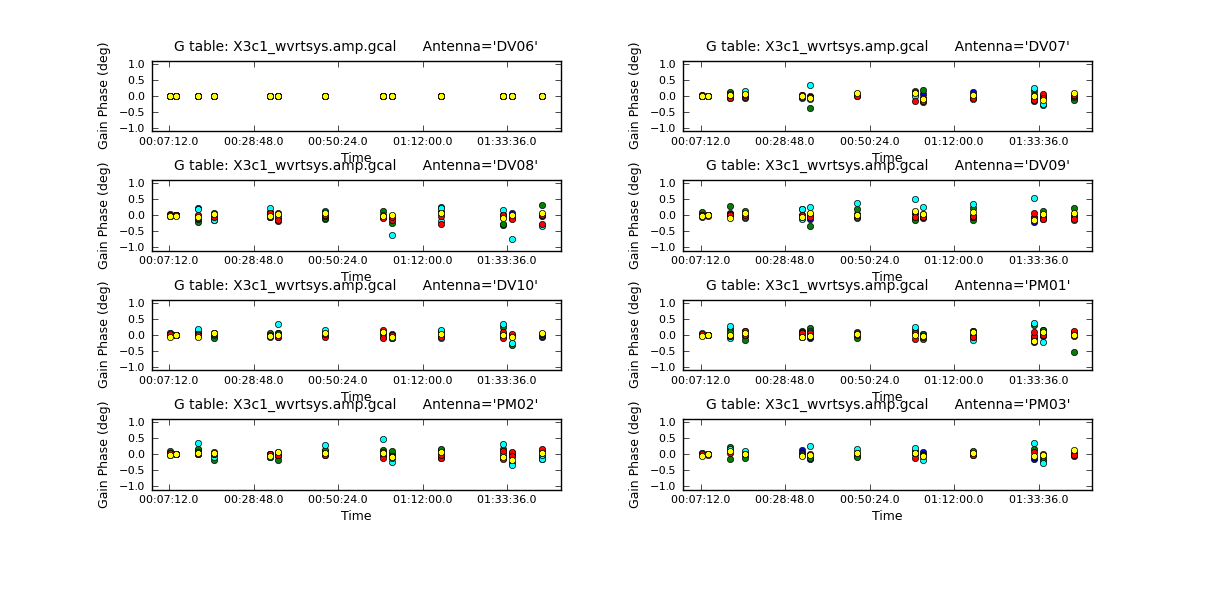
</figure> <figure id="X3c1_wvrtsys.amp_X.png">
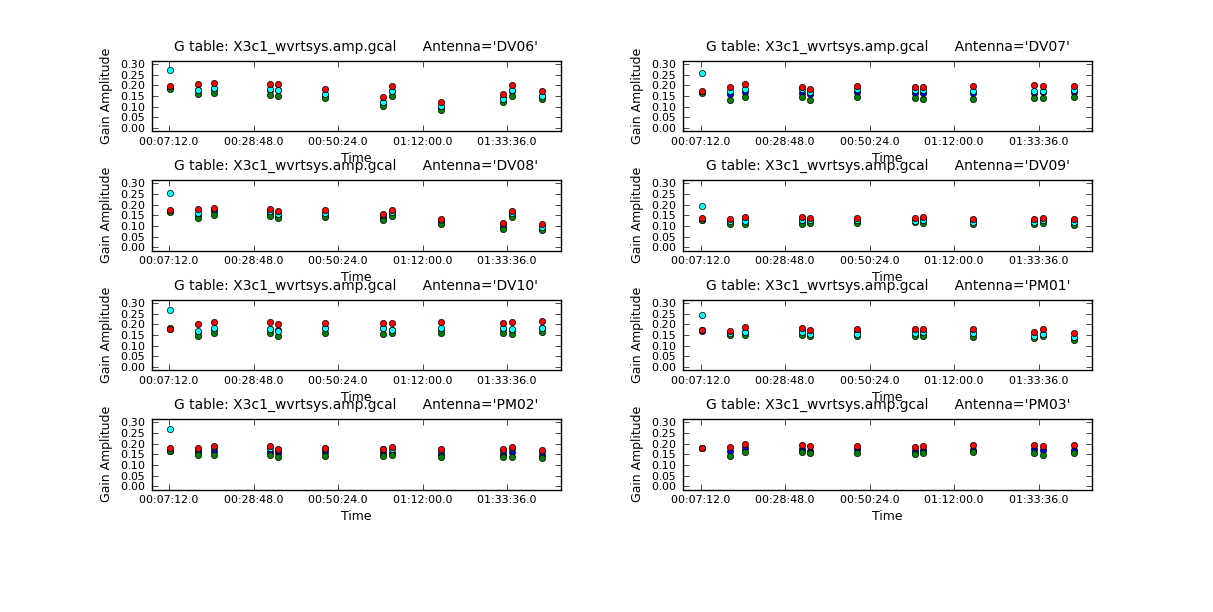
</figure>
# In CASA
plotcal(caltable='X3c1_wvrtsys.amp.gcal',xaxis='time',yaxis='phase',antenna='1~8',
spw='',field='0,1,3,4',plotrange=[0,0,-1,1],
iteration='antenna',subplot=421,figfile='X3c1_wvrtsys.amp_phase.png')
These are very small, as they should be. Now look at the amplitude solutions.
# In CASA
plotcal(caltable='X3c1_wvrtsys.amp.gcal',xaxis='time',yaxis='amp',antenna='1~8',
iteration='antenna',subplot=421,spw='',poln='X',
plotrange=[0,0,0.0,0.3],figfile='X3c1_wvrtsys.amp_X.png')
# In CASA
plotcal(caltable='X3c1_wvrtsys.amp.gcal',xaxis='time',yaxis='amp',antenna='1~8',
iteration='antenna',subplot=421,spw='',poln='Y',
plotrange=[0,0,0.0,0.3],figfile='X3c1_wvrtsys.amp_Y.png')
Flux Calibration
Next we use the flux calibrator (whose flux density was set in setjy above) to derive the flux density of the other calibrators. Note that the flux table REPLACES the amp.gcal in terms of future application of the calibration to the data, i.e. the flux table contains both the amp.gcal and flux scaling. Unlike the gain calibration steps, this is not an incremental table.
# In CASA
fluxscale(vis='X3c1_wvrtsys.ms',caltable='X3c1_wvrtsys.amp.gcal',
fluxtable='X3c1_wvrtsys.flux.cal',reference='1',refspwmap=[0,1,3,3],
listfile='X3c1_wvrtsys.fluxscale.txt')
It's a good idea to record the derived fluxscale values using the listfile option. The values can also be viewed in the Log Messages window.
Found reference field(s): Titan Found transfer field(s): 3c279 J1147-382=QSO J1037-295=QSO Spw=2 will be referenced to spw=3 Flux density for 3c279 in SpW=0 is: 10.5734 +/- 0.0190156 (SNR = 556.039, N = 16) Flux density for 3c279 in SpW=1 is: 10.8103 +/- 0.0258999 (SNR = 417.388, N = 16) Flux density for 3c279 in SpW=2 (ref SpW=3) is: 10.4268 +/- 0.0524249 (SNR = 198.891, N = 14) Flux density for 3c279 in SpW=3 is: 10.0122 +/- 0.0216329 (SNR = 462.822, N = 16) Flux density for J1147-382=QSO in SpW=0 is: 1.04139 +/- 0.0167475 (SNR = 62.182, N = 16) Flux density for J1147-382=QSO in SpW=1 is: 0.838983 +/- 0.0191563 (SNR = 43.7968, N = 16) Flux density for J1147-382=QSO in SpW=2 (ref SpW=3) is: 1.02209 +/- 0.025659 (SNR = 39.8337, N = 14) Flux density for J1147-382=QSO in SpW=3 is: 1.299 +/- 0.0199392 (SNR = 65.1484, N = 16) Flux density for J1037-295=QSO in SpW=0 is: 0.967053 +/- 0.00942059 (SNR = 102.653, N = 16) Flux density for J1037-295=QSO in SpW=1 is: 0.758689 +/- 0.0157661 (SNR = 48.1215, N = 16) Flux density for J1037-295=QSO in SpW=2 (ref SpW=3) is: 0.963367 +/- 0.0181981 (SNR = 52.9377, N = 14) Flux density for J1037-295=QSO in SpW=3 is: 1.23762 +/- 0.0150691 (SNR = 82.1297, N = 16)
<figure id="x3c1_wvrtsys.flux_X.png">
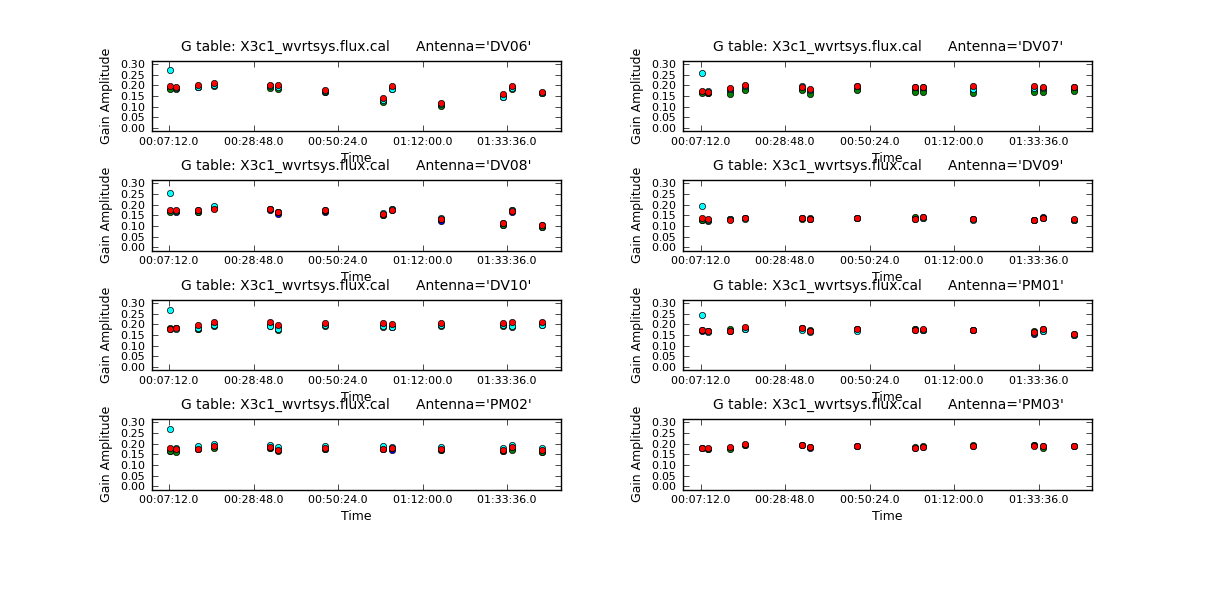
</figure>
Now look at the flux solutions.
# In CASA
plotcal(caltable='X3c1_wvrtsys.flux.cal',xaxis='time',yaxis='amp',antenna='1~8',
iteration='antenna',subplot=421,spw='',poln='X',
plotrange=[0,0,0.0,0.3],figfile='X3c1_wvrtsys.flux_X.png')
# In CASA
plotcal(caltable='X3c1_wvrtsys.flux.cal',xaxis='time',yaxis='amp',antenna='1~8',
iteration='antenna',subplot=421,spw='',poln='Y',
plotrange=[0,0,0.0,0.3],figfile='X3c1_wvrtsys.flux_Y.png')
Apply Calibration and Inspect
Now we can use the flagmanager if we want to restore any of the spectral flagging we did prior to bandpass calibration. In this case, we choose to restore the flags of the emission lines on Titan, because we are interested in seeing how strong they are compared to the continuum. However, we leave the strong ozone line and mesospheric CO line flagged on all sources, because we want to get the most accurate continuum flux density for the science target.
# In CASA
flagmanager(vis='X3c1_wvrtsys.ms',mode='restore',versionname='X3c1_wvrtsys.before_emissionflags')
Next we apply the calibration solutions to each source individually, using the gainfield parameter to specify which calibrator's solutions should be applied from each of the gaintable calibration tables.
First, we do 3C279 (the bandpass calibrator), applying all 3 of its solutions to itself (that's why gainfield contains three zeros):
# In CASA
applycal(vis='X3c1_wvrtsys.ms',field='0',
gaintable=['X3c1_wvrtsys.bandpass.bcal','X3c1_wvrtsys.intphase.gcal','X3c1_wvrtsys.flux.cal'],
interp=['nearest','nearest','nearest'],
gainfield=['0','0','0'], flagbackup=T, calwt=F)
Next, we do Titan (the absolute flux calibrator) using the bandpass solution from 3C279:
# In CASA
applycal(vis='X3c1_wvrtsys.ms',field='1',
gaintable=['X3c1_wvrtsys.bandpass.bcal','X3c1_wvrtsys.intphase.gcal','X3c1_wvrtsys.flux.cal'],
interp=['nearest','nearest','nearest'],
gainfield=['0','1','1'], flagbackup=T, calwt=F)
For the secondary phase calibrator, we apply the phase and flux solutions from the primary phase calibrator. This will allow us to check how well the phase transfer to the science target (TW Hya) has worked:
# In CASA
applycal(vis='X3c1_wvrtsys.ms',field='3',
gaintable=['X3c1_wvrtsys.bandpass.bcal','X3c1_wvrtsys.scanphase.gcal','X3c1_wvrtsys.flux.cal'],
interp=['nearest','linear','linear'],
gainfield=['0','4','4'], flagbackup=T, calwt=F)
Next is the Primary phase calibrator:
# In CASA
applycal(vis='X3c1_wvrtsys.ms',field='4',
gaintable=['X3c1_wvrtsys.bandpass.bcal','X3c1_wvrtsys.intphase.gcal','X3c1_wvrtsys.flux.cal'],
interp=['nearest','nearest','nearest'],
gainfield=['0','4','4'], flagbackup=T, calwt=F)
Finally, for the Science Target TW Hya, we apply the phase solutions from both the primary and secondary phase calibrators:
# In CASA
applycal(vis='X3c1_wvrtsys.ms',field='2',
interp=['nearest','linear','linear'],
gaintable=['X3c1_wvrtsys.bandpass.bcal','X3c1_wvrtsys.scanphase.gcal','X3c1_wvrtsys.flux.cal'],
gainfield=['0','3,4','3,4'], flagbackup=T, calwt=F)
Now we can check the results of applying the calibration solutions.
<figure id="Corrected_vs_time_1.png">
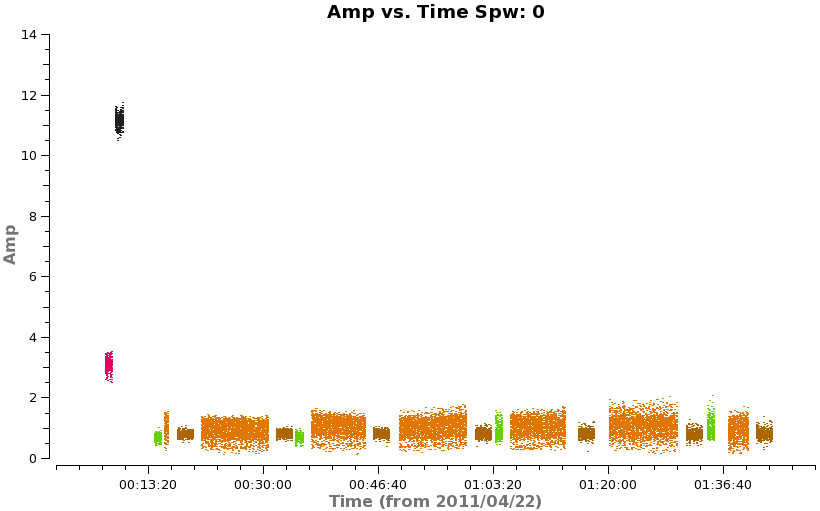
</figure>
# In CASA
plotms(vis='X3c1_wvrtsys.ms',spw='',xaxis='time',yaxis='amp',field='',avgchannel='3840',
coloraxis='field',iteraxis='spw',ydatacolumn='corrected')
In amplitude, it looks good but there are some noisy points toward the end of the first scheduling block, but it mostly only affects the secondary phase calibrator (green). In phase, we expect all the points to cluster about zero. The large scatter in phase on the secondary phase calibrator is readily apparent:
<figure id="Corrected_phase_vs_time_1.png">
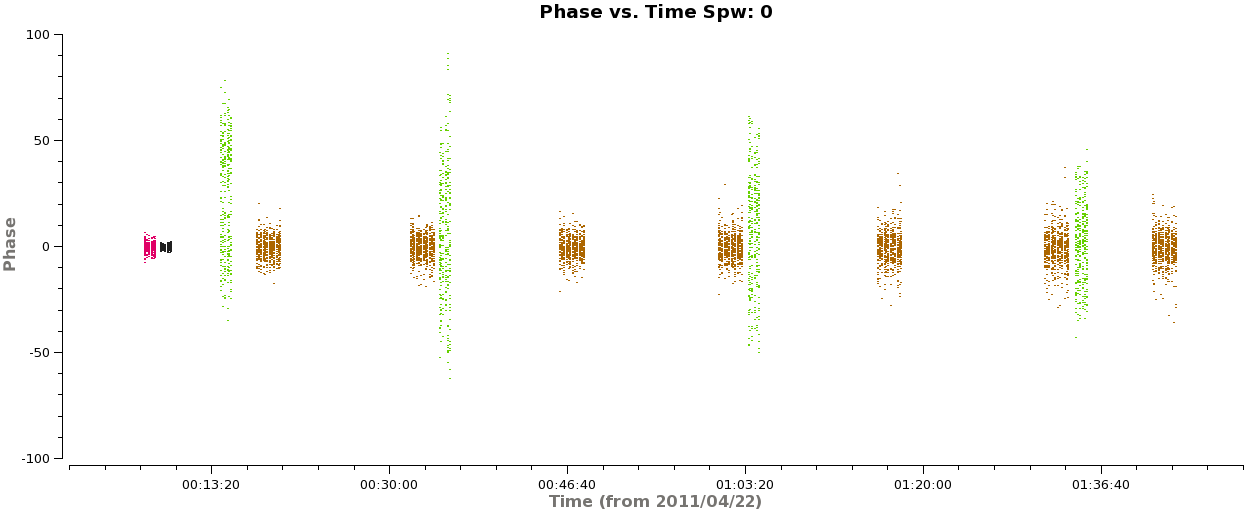
</figure>
# In CASA
plotms(vis='X3c1_wvrtsys.ms',spw='',xaxis='time',yaxis='phase',field='0,1,3,4',avgchannel='3840',
coloraxis='field',iteraxis='spw',ydatacolumn='corrected')
Let's check whether the situation improves when we apply this calibrator's solutions to itself rather than transferring the solutions from the primary phase calibrator (which is 17 degrees away, and observed at a different time).
# In CASA
applycal(vis='X3c1_wvrtsys.ms',field='3',
gaintable=['X3c1_wvrtsys.bandpass.bcal','X3c1_wvrtsys.intphase.gcal','X3c1_wvrtsys.flux.cal'],
interp=['nearest','nearest','nearest'],
gainfield=['0','3','3'],flagbackup=T)
<figure id="Corrected_vs_time_1_field3.png">
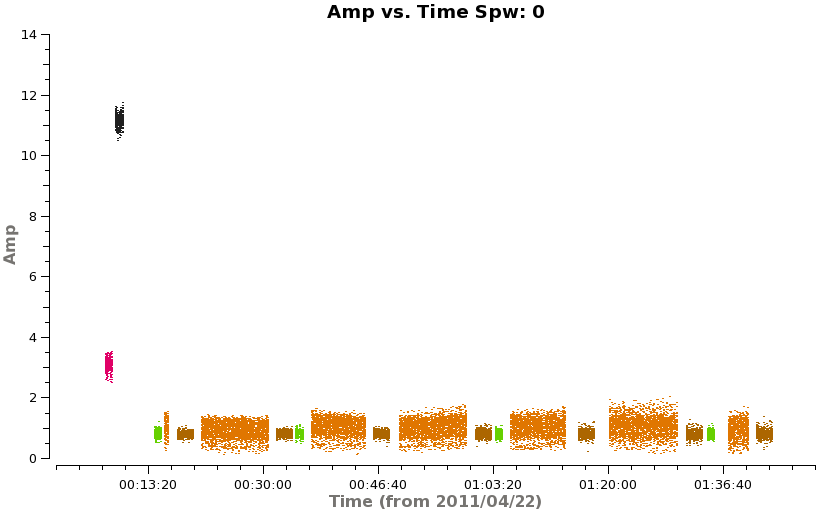
</figure>
# In CASA
plotms(vis='X3c1_wvrtsys.ms',spw='',xaxis='time',yaxis='amp',field='',avgchannel='3840',
coloraxis='field',iteraxis='spw',ydatacolumn='corrected')
<figure id="Corrected_phase_vs_time_1_field3.png">
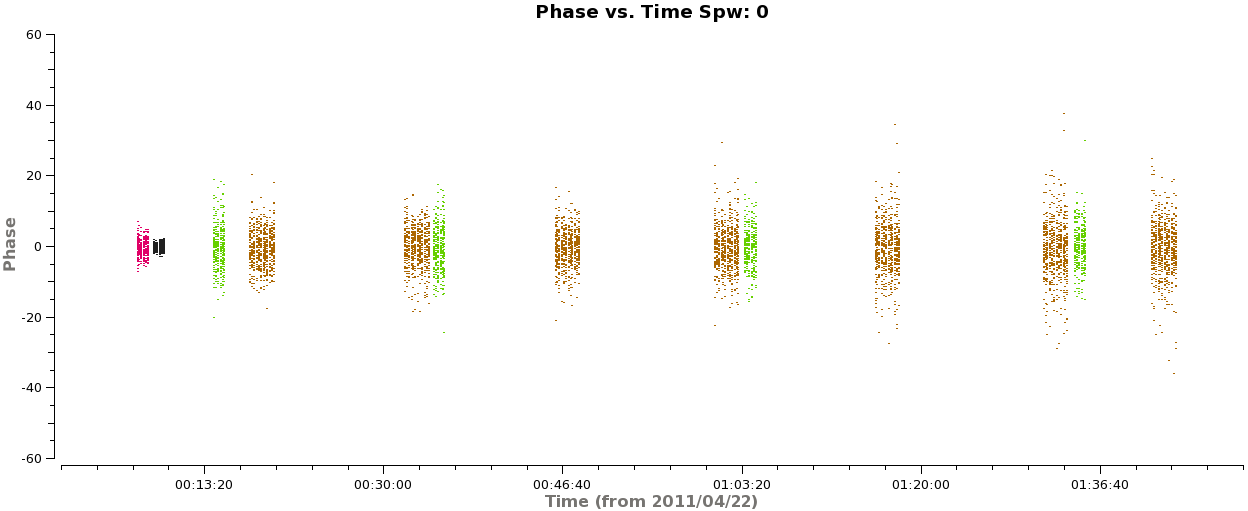
</figure>
# In CASA
plotms(vis='X3c1_wvrtsys.ms',spw='',xaxis='time',yaxis='phase',field='0,1,3,4',
avgchannel='3840', coloraxis='field',iteraxis='spw',
ydatacolumn='corrected')
Indeed, the secondary calibrator looks better now in amplitude and phase. This is an indication that the calibration transfer is not working well in this timerange. Because the effect is not catastrophic and we know we can self-calibrate on TW Hya later, we will let this go for now. Or, if you want you can delve deeper into the data and try to solve the mystery...
In any case, we will re-issue the original applycal so that it is this calibration that our subsequent split will use. This will allow us to check the effect of correcting the secondary phase calibrator with the primary phase calibrator later.
# In CASA
applycal(vis='X3c1_wvrtsys.ms',field='3',
gaintable=['X3c1_wvrtsys.bandpass.bcal', 'X3c1_wvrtsys.scanphase.gcal', 'X3c1_wvrtsys.flux.cal'],
interp=['nearest','linear','linear'],
gainfield=['0','4','4'], flagbackup=T, calwt=F)
Let's check the spectral calibration now. First 3C279 and Titan:
<figure id="X3c1_spw2_corrected_3.4.png">
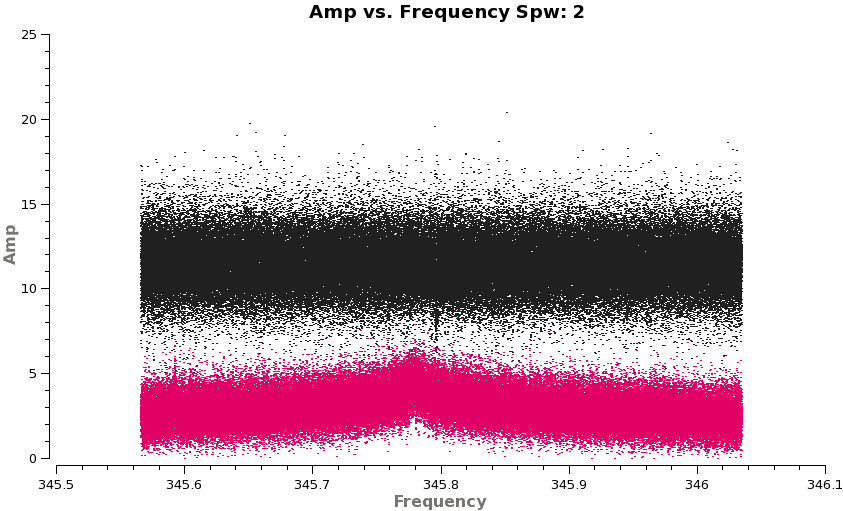
</figure>
# In CASA
plotms(vis='X3c1_wvrtsys.ms',spw='',xaxis='frequency',yaxis='amp',field='0,1',
avgtime='1e8',avgscan=T,coloraxis='field',ydatacolumn='corrected',
iteraxis='spw',xselfscale=T)
Flip through the spws. These look good. Next the two phase calibrators:
# In CASA
plotms(vis='X3c1_wvrtsys.ms',spw='',xaxis='frequency',yaxis='amp',field='3,4',
avgtime='1e8',avgscan=T,coloraxis='field',ydatacolumn='corrected',
iteraxis='spw',xselfscale=T)
Flip through the spws. This also looks good, the secondary phase calibrator is a bit noisier but this is normal. The upswing at the lower frequency end of spw=3 will probably need to be flagged on the science target as well. It corresponds to the edge of an atmospheric feature.
Now for the exciting part, what does the science target look like...
# In CASA
plotms(vis='X3c1_wvrtsys.ms',spw='',xaxis='frequency',yaxis='amp',field='2',
avgtime='1e8',avgscan=T,coloraxis='field',ydatacolumn='corrected',
iteraxis='spw',xselfscale=T)
We see HCO+(4-3) in spw=0 and CO(3-2) in spw=2 as expected. Because the shape of the line profiles varies with baseline, you can already tell that the line emission is resolved.
<figure id="X3c1_CO3_2_uvplot_3.4.png">

</figure> <figure id="X3c1_HCOp4_3_uvplot_3.4.png">
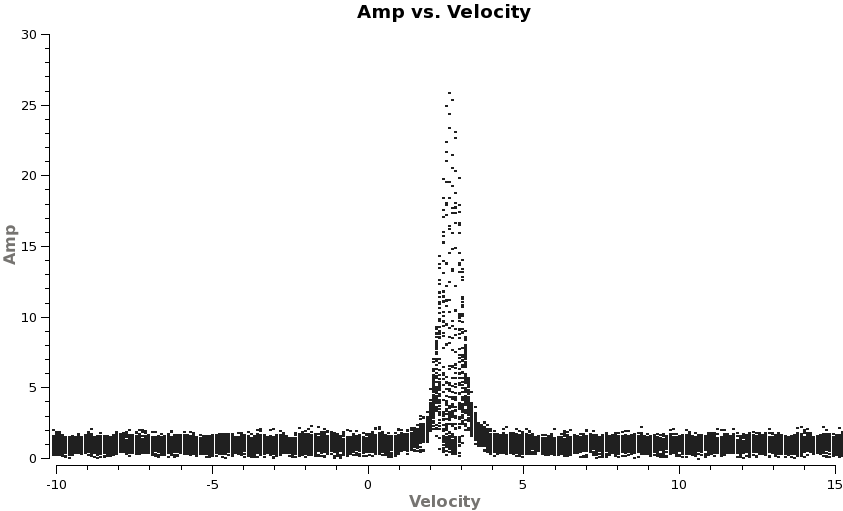
</figure>
Now check that the velocity of TWHydra is correct in the LSRK frame, it should be around 2.88 km/s.
- CO 3-2 rest freq 345.79599 GHz
- HCO+ 4-3 rest freq 356.7342 GHz
# In CASA
plotms(vis='X3c1_wvrtsys.ms',spw='2',xaxis='velocity',yaxis='amp',field='2',
avgtime='1e8',avgscan=T,transform=T,freqframe='LSRK',
restfreq='345.79599GHz', plotrange=[-10,15,0,0],coloraxis='spw')
# In CASA
plotms(vis='X3c1_wvrtsys.ms',spw='0',xaxis='velocity',yaxis='amp',field='2',
avgtime='1e8',avgscan=T,transform=T,freqframe='LSRK',
restfreq='356.7342GHz',plotrange=[-10,15,0,0],coloraxis='spw')
Both lines show up at the expected velocity.
At this point the full guide you would combine all three calibrated Measurement Sets into a single Measurement Set using the 'concat' command. In this version, we will proceed with our single Measurement Set.
Split Calibrated Data
Now we split off the calibrated data for the Science Target as well as the interesting parts of the calibrators for imaging.
First, split out TW Hydra itself (Field 2)...
# In CASA
os.system('rm -rf TWHydra_corrected.ms')
split(vis='X3c1_wvrtsys.ms',outputvis='TWHydra_corrected.ms',
datacolumn='corrected',spw='',field='2')
Now split out the two quasar phase calibrators...
# In CASA
os.system('rm -rf J1037_corrected.ms')
split(vis='X3c1_wvrtsys.ms',outputvis='J1037_corrected.ms',
datacolumn='corrected',spw='',field='4')
# In CASA
os.system('rm -rf J1147_corrected.ms')
split(vis='X3c1_wvrtsys.ms',outputvis='J1147_corrected.ms',
datacolumn='corrected',spw='',field='3')
The third quasar, 3C279, (our bandpass calibrator) showed CO absorption. Split out that part of the data separately.
# In CASA
os.system('rm -rf 3C279_CO3_2.ms')
split(vis='X3c1_wvrtsys.ms',outputvis='3C279_CO3_2.ms',
datacolumn='corrected',spw='2:1900~2000',field='0')
For Titan we separately split out a continuum window and the CO(3-2) line:
# In CASA
os.system('rm -rf Titan_cont.ms')
split(vis='X3c1_wvrtsys.ms',outputvis='Titan_cont.ms',
datacolumn='corrected',spw='0',field='1')
# In CASA
os.system('rm -rf Titan_CO3_2.ms')
split(vis='X3c1_wvrtsys.ms',outputvis='Titan_CO3_2.ms',
datacolumn='corrected',spw='2',field='1')
Continue on to Imaging of the Science Target
If you finish during the morning, you can proceed to the imaging below. Alternatively, you may want to go back and step through the application and inspection of the WVR and Tsys tables (if you skipped them) or try imaging your calibrators (the 3c279, Titan, etc.).
Now you can continue on to the imaging guide.
